#its a crime hes not been in anything mainstream for like... 9 years?!?!!
Explore tagged Tumblr posts
Text
GUYS HE'S ALIVE

THIS IS NOT A DRILL
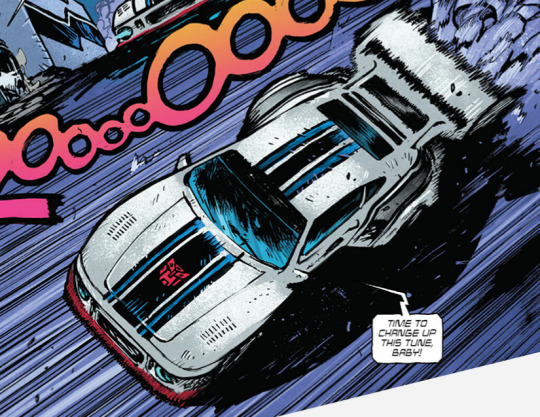


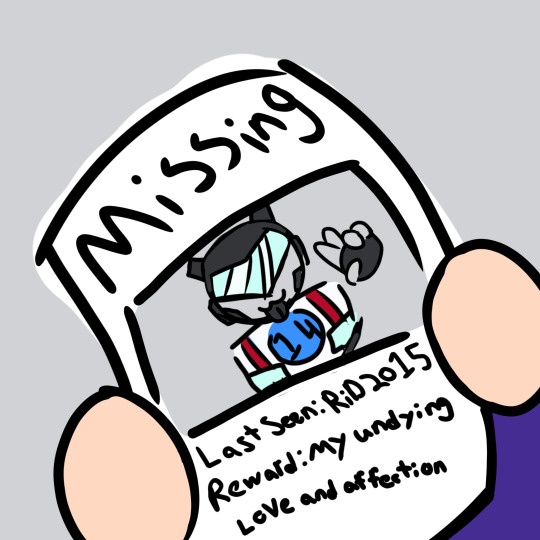
PLEASEEEEEEEEEEE
#not new but im just reading these now#so#yes ik he's been in other comics but STILL#its a crime hes not been in anything mainstream for like... 9 years?!?!!#I STILL MISS HIM#BUT IM AT PEACE#also hello account i semi forgot abt#how u doin#transformers#transformers jazz#tf jazz
221 notes
·
View notes
Text
5 Favorite First Viewings of July 2021
Quick note: Hi everyone, I'm back, things have honestly been getting better for me, and I'm glad to be on this site full of cinephiles, people that are too horny, and cinephiles that are too horny. I'll be more active on here. But anyway, let's talk about some movies.
Beyond the Valley of the Dolls (1970) (dir. Russ Meyer)
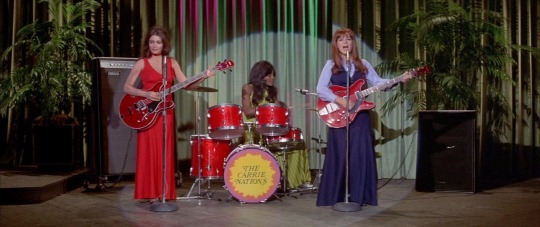
CW: Abortion mention
What a picture. What a gorgeous, sexy, horrifying slice of what Hollywood and star life can do to a bunch of bright-eyed young people looking for success. Also is a critique of how macho nature can ruin friendships and romantic relationships with total ease. I was obsessed with the scene transitions, like Pet pouring pancake mix onto a plate after the abortion scene, or Kelly singing after someone screams before their murder in the opening scene.
Great, campy flick with exceptional music too.
Deep Cover (1992) (dir. Bill Duke)
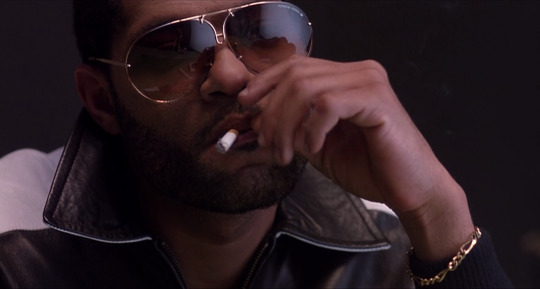
Laurence Fishburne plays Russell Stevens, a Cincinnati police officer who hopes to do well by the community, to make a difference. He’s traumatized by the death of his substance-abusing father, and wants to make sure that he can help the people of his own town. He goes undercover on assignment as a drug dealer, where his boss orders him to take down the kingpin. Stevens realizes the police’s own failings while on assignment. The racist abuse he takes from Agent Carver, and the realization that the police department is protecting drug kingpins like Gallegos and Barbossa. Giving drugs to Black kids and Latinx kids so there will be less of them. The cops are no different than the drug kingpins looking to make filthy amounts of money.
Fishburne’s performance is excellent, as Stevens feels he has to maintain a stone face so he doesn’t get caught by Jason or Barbossa or any of his cronies, but also he maintains a stone face to try and hide his emotion, his trauma. But when he gets pissed, Fishburne acts it beautifully, as is when he has to deliver a funny quip to counter Jason’s douchebaggery. And the production design, holy fuck, the sets and the lighting.
A perfect neo-noir for the HW Bush years, arguably one of the most timeless commentaries on the era, as well as the police as a whole.
Fast Five (2011) (dir. Justin Lin)
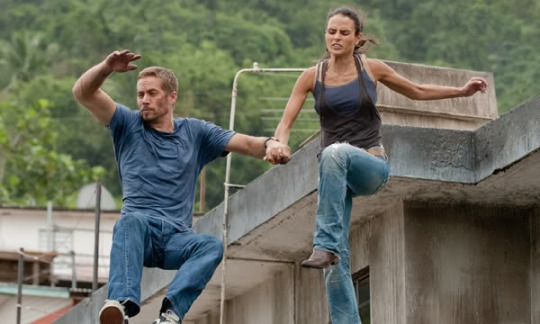
I was torn between including this or Furious 7, but I ultimately went with Fast Five because it felt like an important turning point in the series, it's a great heist film, and it reached the same chaotic highs and genuinely excellent filmmaking that I had been waiting for since 2 Fast and Tokyo Drift.
Fast Five opens where Fast & 4ious left off. Dom is hauled away to prison on a bus. Mia and Brian drive in their high-tech cars and knock the bus over, helping Dom escape. The title drops. Fast Five. It’s such an intense yet short action scene, and dropping the title immediately after it lets the viewer know that this movie is not fucking around. It’s arguably gonna be more intense and insane than the previous one.
And it is. The filmmakers made the decision to use a lot more practical stunt work for the film, and as a result, it leads to, so far, the best action in the entire series, since 2 Fast and Tokyo Drift. It’s not just how it’s shot or edited, it’s the geography of the locations, the rooftop chase echoes the rooftop chase of Jackie Chan’s masterwork Police Story, particularly the way each character bounces from top to top.
And of course, there’s the silliest moment in the movie, the one that matches the intensity and kineticism of a film like 2 Fast, which is driving the Reyes’ bank vault throughout the street, getting chased by corrupt cops.
I know we make fun of Vin Diesel for saying “family” all the time in these films, but there’s a reason we remember him saying all of these impassioned monologues. Because he’s unbelievably sincere, and has so much love in his heart for every single person in the room. Anytime he delivers a speech to any of them, it’s genuinely heartwarming.
This is the film that finally shows La Familia in their best environment, which is working together, in a movie genre that allows them to work together, which is a heist film. And a great one at that.
Last Days (2005) (dir. Gus Van Sant)

CW: Mention of suicide
Several films have been made about legendary rock artist Kurt Cobain, and for good reason. He is one of the most tragic figures in rock and roll. A tortured genius who has written and performed classic song after classic song with his band Nirvana. He was called the voice of a generation, and helped change the face of mainstream alternative rock music as we know it. But with that fame, and all of those expectations came a worsening depression and further drug abuse, and his eventual death. But most of the films about Kurt Cobain ask one question which gets under my skin way too much:
“Who REEEEEEEEEEAAAAAAAAAAAAAAALLY killed Kurt Cobain?”
It was him. He did. And it’s okay, I’m sad too. Thinking that Kurt Cobain was murdered is completely ignoring the depression that he faced. And despite Last Days being more inspired by the death of Cobain rather than actually about it, it feels much more honest than the conspiracy documentaries on his death, wanting to leech off of his dead body.
This is the last installment of Gus Van Sant’s “Death Trilogy”, the previous two installments being Gerry (2001), and Elephant (2003). While I have not seen Gerry, I have seen Elephant though, and love that film for its minimalist, raw nature, and its boldness for not romanticizing the school shooter or the lives they had taken. Last Days falls into that trap once, as I don’t agree with the shot of Blake’s soul climbing up a ladder, that always struck me as cheesy in a film that is anything but.
Last Days is similar to Elephant in terms of the way it is filmed. Its usage of long takes, and still shots of characters doing various things, such as Blake playing his guitar behind a drum set. The way these moments are shot is similar to a Chantal Akerman film, particularly Jeanne Dielman. Where the acts of the mundane are the stars of the film. Blake wanders around an empty house, and the viewer can feel the pain, not just through Michael Pitt’s acting, but from the house itself. Its decay, its paint peeling from the walls, from the soft glow of the lamp that lights his face.
I say this is the most honest film about Kurt Cobain, because, despite the characters technically being fictional (the main character who looks, walks, and acts like Cobain is named Blake), this film focuses on the mental state of a person before they eventually take their own life. They’re still working, still making music, still trying to talk to friends and bandmates, but the depression lingers on. Not once does this film try to make you believe that someone else killed him, because you can see the signs of his own suicide taking place just through the film’s excellent cinematography by Harris Savides, showing his mental state only growing worse through the production design.
And it’s empathetic with him. There’s no judgement for leaving rehab, there’s no finger-wagging at him or the people he was with, there’s just a silent prayer at the end of the film, hoping that he is in a better place than he was.
Sometimes you don’t need to show every event that led you to where you are, all you can show is the moment, which also makes this better than most biopics as well, as it never feels messy or muddled, just showing one moment of Blake/Kurt’s life.
I really loved this film, and I’ll be writing about it in full soon.
The Village (2004) (dir. M. Night Shyamalan)
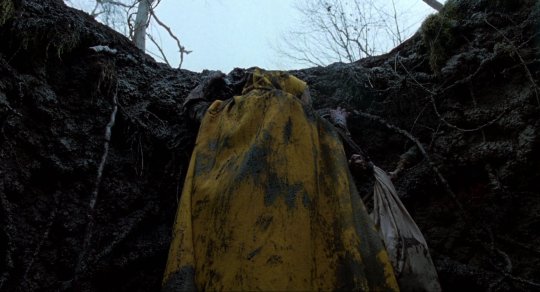
The Cracked.com/Channel Awesome audience stuck in 2012 will tell you that this was the beginning of the end for Shyamalan. That this was when people stopped taking him seriously, that this was when he became more of a punchline because of his twist endings.
But why?
The Village was released in 2004, deep in the Bush administration, during the early stages of the Iraq War. The leaders of the time were talking about imaginary boogeymen, terrorists that would attack the civilians if they could. Because of 9/11, politicians could get away with these false ideas with the majority of Americans fully believing them. The boogeymen in The Village are “The People We Don’t Speak Of”, monsters attracted by the color red. Yet we find out that they are all costumes made by the Elders of the land, designed to prevent people from going outside the land. They rule by fear disguised as love. They’ve gone through their own traumas through the deaths of their family members, but they’ve decided to completely abandon the lives that they’ve had and have their children living lies.
9/11 impacted American life by teaching citizens to live primarily by fear, to not trust anyone but their own people. And yet, post-9/11, all that increased was not “coming together”, but hate crimes against South Asian people. The rage white Americans had felt led to conservative politicians pushing fear-mongering agendas, and said white Americans blindly accepted. The outside world was progressing, but too many people were fine with living with further conservative politics only regressing American life further and further back, all for the illusion of safety. Meanwhile, the only threats to them were not the brown citizens outside of America they were so afraid of, but the white elders, the white politicians.
The Village explores these fears so eloquently, all while having a terrifying atmosphere, an enchanting score, and brilliant sound design. I enjoyed this movie very much.
Other viewings I enjoyed:
Beavis and Butt-Head Do America (1996) (dir. Mike Judge) (re-watch)
Blow Out (1981) (dir. Brian de Palma) (re-watch)
Clueless (1995) (dir. Amy Heckerling) (re-watch)
Furious 7 (2015) (dir. James Wan)
The Long Goodbye (1973) (dir. Robert Altman)
Lupin III: The First (2019) (dir. Takashi Yamazaki)
Unbreakable (2000) (dir. M. Night Shyamalan) (re-watch)
Velvet Goldmine (1998) (dir. Todd Haynes)
The Visit (2015) (dir. M. Night Shyamalan)
#favorite first watches#these movies are (chef's kiss)#beyond the valley of the dolls#russ meyer#deep cover#bill duke#fast five#justin lin#last days#gus van sant#the village#m night shyamalan
21 notes
·
View notes
Text
Best Serial Killer Movies of the ’90s Ranked
https://ift.tt/3tcsgCf
Someone must have left the freezer door in the morgue open, because grisly reminders of the past are thawing before our eyes. You can see it this weekend with the release of John Lee Hancock’s The Little Things, a throwback to the days when movie stars hung out at crime scenes instead of in spandex, and it’ll be more apparent next month with the launch of Clarice, a television spinoff of 1991’s The Silence of the Lambs. All the evidence points to only one conclusion: the serial killer thrillers of the ‘90s are back!
Not that we’re complaining. For a macabre minute or two, every Hollywood name appeared eager to play either the detective or the killer—the hunter or the obsessed, which often proved interchangeable for both characters. Granted that means there can be something formulaic about many of these movies. Yet they can also be bleak, hard-edged, and ambiguous. From our modern gaze, where the dominant studio conventions prefer reassuring morality tales and sunny lighting, these movies’ preference for shadows and discomfort in the mainstream is kind of startling.
So grab your magnifying glass and fortify your stomach, because we’re about to revisit some of the best (and worst) of ‘90s serial killer thrillers. (Also this list is strictly for the decade when the genre was at its height and it excludes slasher movies like Scream, which may feature serial killers but were not exactly adult-oriented thrillers.)
12. Eye of the Beholder (1999)
Eye of the Beholder is a tonal oddity that only passingly flirts with the conventions of ‘90s serial killer thrillers, all while it tries to pay homage to (read: rip-off) Alfred Hitchcock. But any credit it deserves for deviation—including making Ashley Judd’s central femme fatale the killer—it loses in execution. As a muddied, impenetrable tale about an intelligence officer (Ewan McGregor) who spies on and falls in love with a serial killer, Eye of the Beholder is a scattershot of bad ideas that run the gamut from ludicrous to misogynistic.
Beauty may be in the eye of the beholder, but this movie will close the lids over your pupils inside of 30 minutes.
11. Nightwatch (1997)
It feels a little mean to rag on Ewan McGregor back-to-back, but maybe serial killer movies just aren’t his genre? That could be at least one takeaway from an ill-advised double feature of Eye of the Beholder and Nightwatch, the latter of which is a remake of a 1994 Danish film that I’ve not seen… and probably won’t since both the original film and American remake are directed by the same man.
McGregor plays medical student Martin here, a kid who gets an after school job by becoming the night watch security at the local morgue. But as a series of grisly prostitute murders pile up, Martin realizes he needs to figure out who the killer is—that or continue to be framed by the necrophiliac fiend who keeps coming by the morgue for one last liaison. It’s exactly as skeevy as it sounds. Do yourself a favor and go your whole life without hearing Nick Nolte sing “This Old Man” while climbing onto a corpse.
10. Natural Born Killers (1994)
The movie that Quentin Tarantino disowned, Natural Born Killers is a seedy mess based on a Tarantino script that was heavily rewritten by Oliver Stone, David Veloz, and Richard Rutowski. The concept itself is a seemingly inevitable escalation of the “bad romance outlaws” archetype that’s been floating around Hollywood since at least 1950’s Gun Crazy, and which was then made iconic by Bonnie & Clyde (1967).
But whereas those films relied on bank robbers living fast, Natural Born Killers descends into a seeming final form with Mickey and Mallory (Woody Harrelson and Juliette Lewis) as giddy serial killers who are eventually out for maximum carnage. Technically the pair are supposed to be presented as victims of traumatic child abuse—and who are then wrongfully glorified by the media. But Stone’s sloppy and tanked vision lacks the discipline to achieve anything beyond its maliciousness. Early sequences imagining Mallory’s abusive childhood like it’s a television sitcom, and later psychedelic visions of Robert Downey Jr.’s opportunistic news reporter as the Devil, do little to divorce the film from its shallow self-satisfaction in close-ups of heads being shot.
The movie came under controversy in the years after its release for inspiring alleged copycat killers as well as school shooters. It feels irresponsible to blame media for actual violence, but it’s still quite an indictment that Stone’s attempt to criticize media glorification became a favorite for many a disturbed individual with a gun.
9. Kiss the Girls (1997)
When studying competent, middle of the road Hollywood thrillers, Kiss the Girls is a solid place to start. As a decently made bit of studio convention, the movie is anchored by strong elements like Morgan Freeman as James Paterson’s literary hero, Alex Cross, and Ashley Judd as Kate, the victim who survives a masked killer’s attempt to abduct her into his harem.
Moments like Kate’s escape sequence through the North Carolina wilderness are effectively filled with adrenaline, and Judd particularly gives the salacious piece conviction. However, it is salacious to a fault. Even if the movie toned down the source novel’s even more lurid misogyny, the film studies Kate and the other victims with a lascivious male gaze, blurring sex with violence, real world horror with leering entertainment. Right down to its title, the film can be rightly criticized as Hollywood glamourizing another story about violence against women. Whether that damns the whole movie depends on the viewer, but it certainly keeps it low on our list.
8. The Bone Collector (1999)
Marketed with a hell of a tagline about there being thousands of taxi cabs in New York City that’ll get you home—and one that won’t—The Bone Collector is almost comically slavish to the clichés of ‘90s moviemaking. The wrinkle here is that after a faux cab driver begins abducting his victims off the street, the crime psychologist who must stop him is entirely stuck by his bedside. Due to a tragic accident, Denzel Washington’s Lincoln Rhyme is paralyzed from the neck down. Yet he is still able to catch serial killers by communicating in the earpiece of police officer Amelia Donaghy (an entirely unconvincing Angelina Jolie).
Read more
Movies
Lost Girls Review: Netflix Takes on the Long Island Serial Killer
By Rosie Fletcher
Books
The Last Book on the Left Takes on the Grim History of Serial Killers
By Alec Bojalad
Together the pair stay one step behind the mystery killer’s tracks as he executes a series of increasingly gruesome and ridiculous murders. It’s preposterous, and in some ways a forerunner for Saw with the satisfaction it takes in absurd death traps, but Washington is effortlessly compelling, even when he never leaves his apartment. As a bit of absurd Hollywood fluff, right down to the ultimately lackluster unmasking of the killer, it can be entertaining, even if you’ll deny it afterward.
7. Copycat (1995)
More potent than I remembered, Copycat is a genuinely well-crafted Hollywood thriller that may not reinvent the wheel but takes it out for a damn good spin. In the driver’s seat is Sigourney Weaver as Dr. Helen Hudson, a criminal psychologist who is an expert on serial killers until one follows her into the bathroom after a guest lecture. He nearly hangs her from the ceiling. Following that white-knuckled opening, the film jumps years ahead and Helen has become agoraphobic and afraid to leave her home.
Yet when a local series of murders reveal the pattern of a predator imitating the methods of his favorite “celebrities”—one crime scene is like the Boston Strangler and another emulates the horrors of Jeffrey Dahmer—Helen is pulled out of retirement by a no-nonsense detective (Holly Hunter). The winning chemistry between Weaver and Hunter—who are refreshingly free from the studio-mandated romantic subplots in some of the other movies on this list—and the blunt force power of their performances aid this sincerely disquieting flick. A needlessly convoluted third act aside, the movie still works as a warning about the danger of fanboys a generation early.
6. Fallen (1998)
Denzel Washington appears again thanks to this clever supernatural spin on the serial killer genre. At the beginning of Fallen, Washington’s John Hobbes appears on top of the world. The serial killer he chased for years (Elias Koteas) is about to breathe deeply in the gas chamber. Yet after the lever is pulled, and with Koteas singing the Rolling Stones’ “Time is On My Side” until his last breath, a funny thing happens: the murders continue.
In fact, more than just the killings, strangers in the street sing “Time is On My Side” in Hobbes’ ear, and he soon realizes that he faces a devil of a killer whose been operating since the beginning—quite literally since the villain is a demon who was once an angel that fell with Lucifer. It’s a bizarre premise given strutting confidence thanks to Washington’s performance, as well as good supporting work by John Goodman and Donald Sutherland. Twenty years later and its ending still sticks with me.
5. The Exorcist III (1990)
If you haven’t seen The Exorcist III, we know what you’re thinking: “Really?!” Yes. In fact, this isn’t even an exorcist movie; it should’ve been titled Legion like the 1983 novel it’s based on. Alas writer-director William Peter Blatty was forced to use the title and do reshoots that added an exorcism in the climax. Still, this supernatural thriller which involves a serial killer back from the dead is far better than it has any right to be.
Following the character of Lt. Kinderman from the 1973 masterpiece, the middle-aged gumshoe is now played by George C. Scott instead of the late Lee J. Cobb, and he possesses Scott’s usual love for contrasts between the restrained whisper and a bombastic howl. He also makes a sympathetic, secular detective forced to face the horrors of Hell when a series of murders committed against Catholic priests appear to be the work of the Gemini Killer (Brad Dourif), a serial killer whom Kinderman sent to the chair more than 10 years ago.
Read more
Movies
The Exorcist III is a Classic and Better Than You Remember
By Jim Knipfel
Movies
The Exorcist Is Still the Scariest Movie Ever Made
By David Crow
Somehow the fiend—plus Kinderman’s long dead pal Father Damien Karras (Jason Miller)—appear to now be living in the same body of a John Doe kept in a mental asylum. With an unrelenting atmosphere of dread, palpable tension, and more of Blatty’s intellectual struggle with concepts of faith and evil, the film is more high-minded than its hacky title suggests. It also features one of the best jump scares in movie history.
4. Summer of Sam (1999)
The only movie on this list directly based on an actual serial killer’s crimes, Spike Lee’s Summer of Sam is a serious-minded joint. However, it’s only partially about the murders perpetrated by David Berkowitz, aka the “.44 Caliber Killer,” aka the Son of Sam. Rather the film focuses on the effects a serial killer has on the culture of New York City during the sweltering summer of 1977, and how it affects young lives trying to make it in the big city.
Influenced by Lee and his co-writers Michael Imperioli and Victor Colicchio’s memories of growing up in 1970s New York, the pic is a love letter to a grim moment in history when the city was about to explode with murders, blackouts, crime, and disco. All of this is digested from the vantages of Vinny (John Leguizamo), a philandering hairdresser guilt-ridden for cheating on his wife (Mira Sorvino), and his childhood pal Ritchie (Adrien Brody), who’s left the old neighborhood behind to join the fledgling punk rock scene.
With a greater interest in how a serial killer affects the culture and institutions of a city on edge than being a traditional crime drama, Summer of Sam is a bit of a forerunner to David Fincher’s far more polished Zodiac from a few years later. With heavy-handed dialogue and a plot too big for Lee to fully get his arms around, even at 142 minutes, Summer of Sam can be uneven and messy. But it has the sweaty incorrigibility of a long night out, and of revelries half remembered like from a fever dream.
3. The Talented Mr. Ripley (1999)
The rare serial killer movie told entirely from the perspective of the killer, Anthony Minghella’s The Talented Mr. Ripley is disarmingly creepy. Despite its glossy awards bait sheen, there is a cold-blooded streak that runs deep to the heart of the piece, likely due to Patricia Highsmith’s source 1955 novel. Starring Matt Damon fresh off his Good Will Hunting golden boy sheen, the film uses its casting to disorient and ultimately disturb.
Like Highsmith’s book, the film is not structured like a traditional thriller. It instead favors a detached ambivalence about its seemingly nebbish hero as he agrees to become an errand boy for the rich by traveling to 1950s Italy in order to retrieve a silver spoon cad (Jude Law) for his father. But the more time Tom Ripley (Damon) spends with Law’s Dickie Greenleaf, the more he grows envious of Dickie’s lifestyle, his wealth and confidence, and maybe even his affection for socialite Marge (Gwyneth Paltrow). There is a subtle—too subtle due to ‘90s Hollywood conventions—homoerotic undercurrent throughout the film as Ripley slowly works up the courage to take his first life. It won’t be his last.
Read more
Movies
Knives Out: When Murder Makes You a Better Person
By Natalie Zutter
Movies
Seven: The Brilliance of David Fincher’s Chase Scene
By Ryan Lambie
Highsmith wound up publishing four subsequent sequels to The Talented Mr. Ripley, but unfortunately no more were made with Damon. Perhaps because this was too unsettling for an ongoing franchise.
2. Seven (1995)
While watching David Fincher’s masterful Seven, the thing that immediately stands out is the oppressive nihilism that permeates throughout. There were decades of neo noir before this detective yarn about the hunt for a serial killer, but none demonstrated such an overbearing sense of despair before the opening credits were even concluded. And perhaps what makes it unshakable is how welcoming the film is toward bleakness; it succumbs long before the gut-punch finale.
Telling the story of an old cop days from retirement (Morgan Freeman) and a hotheaded rookie detective (Brad Pitt), Andrew Kevin Walker’s script has an economy of pace that still impresses despite its cynicism. Very quickly one murder becomes two, then three, and soon four. Yet none of the atrocities are reveled in by Fincher’s blocking; they’re off-screen mutilations which leave psychic damage on his two leads and, eventually, us. The deaths also quickly establish a pattern that their serial killer is targeting seven souls, each intended to embody one of the seven deadly sins.
The movie is a classic now for its climax where the killer “John Doe” (a reptilian Kevin Spacey) turns himself in and leads the cops into the darkest pit, but it’s the entire package that makes this one linger more than 25 years later. At the end of the film, Somerset quotes Hemingway by saying, “‘The world is a fine place and worth fighting for.’ I agree with the second part.” I’m not convinced his film does.
1. The Silence of the Lambs (1991)
As the film that kick-started the idea that serial killers could create their own film genre, The Silence of the Lambs still remains the best of its kind. Blessedly unaware that it was creating conventions for countless copycats, the film tells its psychological drama with simplicity and clarity. Whereas other films on this list bask in their bleakness, there is a dogged optimism and even perverse warmth to this Jonathan Demme adaptation of Thomas Harris’ Silence of the Lambs novel. And that’s of course largely attributable to the casting of Anthony Hopkins and Jodie Foster.
As Dr. Hannibal Lecter, Hopkins is of course monumental. It’s a performance that turned a quinquagenarian into an overnight movie star, and became Hopkins’ calling card as he returned to the not-so-good doctor’s well one too many times. Still, he’s undeniably enthralling as Hannibal, a cannibal psychologist with superhuman powers of observation and mental menace. Even so, Foster is often overlooked by critics for her own contributions as the FBI trainee who’s proverbially fed to the incarcerated Lecter—a pretty face to get the serial killer to consult pro bono on the crimes of another mass murderer. It’s just one more example of casual sexism faced by Clarice that gives Foster as much to play as Hopkins.
Read more
Culture
David Fincher’s Zodiac: The Movie That Never Ended
By Don Kaye
Movies
The Little Things Ending Explained
By David Crow
Surrounded by the slights and prejudices of men—be they in law enforcement or straight jackets—Clarice is constantly underestimated. She finds an intellectual rapport with Hannibal, but she pulls herself out of the darkest night, and the screaming of the lambs, without assistance. Her perseverance matched by Hannibal’s darkly seductive qualities is the juxtaposition that makes Silence of the Lambs one of the finest films of its decade.
cnx.cmd.push(function() { cnx({ playerId: "106e33c0-3911-473c-b599-b1426db57530", }).render("0270c398a82f44f49c23c16122516796"); });
The post Best Serial Killer Movies of the ’90s Ranked appeared first on Den of Geek.
from Den of Geek https://ift.tt/3r5iYGk
19 notes
·
View notes
Text
Seasonal depression is on its way back, so why not analyze another scene from Red Dead Depression 2???????
I’ve been meaning to do another screeching ramble about one of Red Dead Redemption 2′s many incredible scenes, but just couldn’t put my finger on which one. So I threw a rock and hit the Saint Denis bank robbery, that’s the story
strap in, motherfuckers, it’s time to regret the concept of empathy
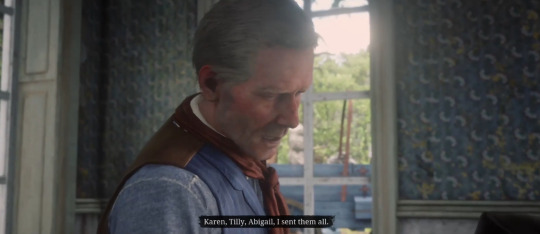
It is such a missed opportunity that we weren’t able to chaperone the girls as they went about putting on their various bullshit personas to gather reconnaissance. I want to see Tilly reading a newspaper with glasses, a fake nose and a mustache
Something Red Dead Redemption 2 spoiled me on is just how much ROI they squeeze into every last line of dialogue. Not a single word feels generic or hamfisted. Every sentence, every twitch and blink, adds up to a greater whole. The more I watch, the more I unearth. There are several AAA titles that frequently get painted with the ‘Good Dialogue’ brush like Uncharted that don’t hold a candle to Rockstar’s work here.
Take Hosea grilling Dutch here, for example:
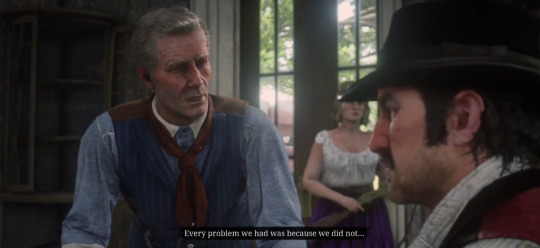
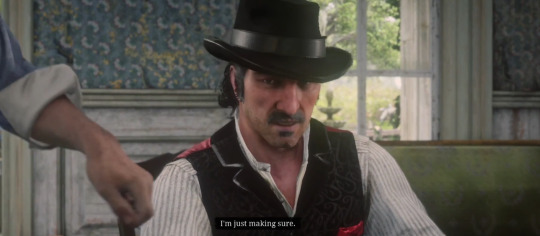
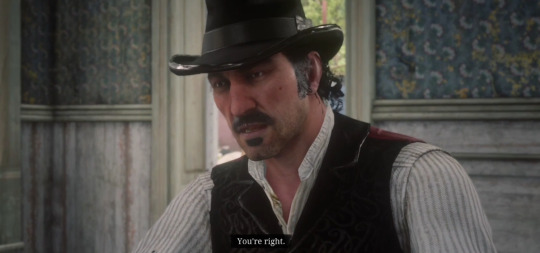
Dutch acquiescing to Hosea’s justified criticism is depressing in its hindsight. Sir Spam der Linde is an arrogant blowhard that could give Dr. Gregory House a run for his money...and yet he still mumbles and bows his head when being told he needs to get his shit together. Compare this to earlier in the game, when he was snipping at both Hosea and Arthur for all their doubts and questions. Double that for the camp interactions you can find where Dutch and Hosea argue about the Blackwater Heist.
Is reality finally sinking in a little for our manic pixie dream man? Does he just have a hard time bullying Hosea, who’s around 5,000 years old and doesn’t give a fuck? For every answer you get, you get another question...and I fucking love it. This character -- and the series at large -- toes the razor-thin line between transparent portrayals and thicc layers of intrigue. This kind of carefully sewn subtlety is sorely lacking in not just videogames, but mainstream media in general. Sometimes I still can’t believe I got to experience this game.
This little scene is just one of many ingredients to make you wonder that, if the bank job had turned out all right...if Dutch really would’ve started changing for the better.
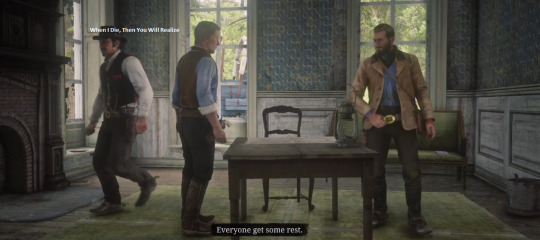
Arthur clutching his belt buckle like he clutches my neck in my dreams
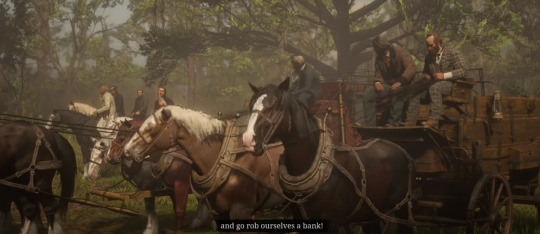
So the plan is made and the cowboys are off to Sand Penis, and I bet nobody in the history of the world has made that joke before
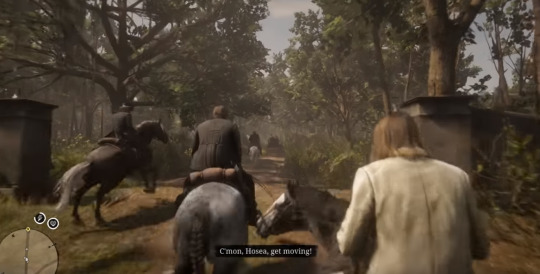
Just the build-up to the bank sends goosebumps up my arms.
Even with apprehension in the back of your mind, it’s hard not to get sucked into the whirlwind of adrenaline here. You have each member playing their part, from Abigail as the helpless damsel to Charles and Bill as crowd control. Great back-and-forth dialogue as characters anticipate what’s about to happen (with some delicious doubting from John). It’s like a group project, except you don’t want to slap your partners!!!*
*except micah ‘I Haven’t Scrubbed My Nailbeds In Fifty-Three Years’ bell
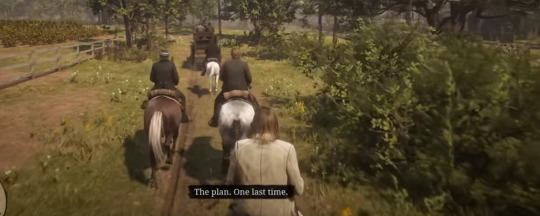
Fun fact: if Dutch hadn’t said ‘one last time’, the bank robbery would’ve been a success. Should’ve browsed TVTropes.
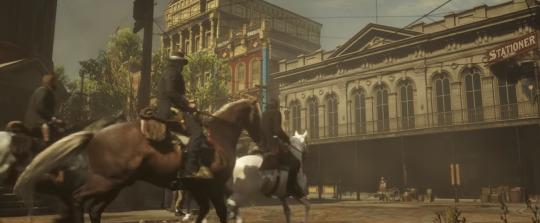
The direction of this game remains impeccable.
This is a simple shot of a few dudes riding their horse...and it’s made just that much grander by the camera angles, slung low to the ground to create a stronger sense of scale. With the tense drums in the backing track and the sudden quiet that’s befallen our beloved anti-heroes, this provides the perfect finishing touches to one of the most memorable and stressful parts of the game:
The runway.

We start off this display of cowboy couture with Dutch Fam Der Linde, well-known in the West for wearing crushed velvet while hiking the open trail. Dashingly long coattails make up the bulk of this iconic look, with a sexy pop of red to round it all out. A complimentary red bandana lined with a hint of gold brings out the buttons, chain and belt buckle. Very regal. Much fucky. Still want to slap him for future crimes, so 9/10
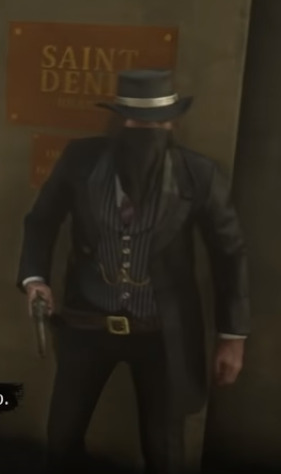
A surprising comeback from the man who invented skid marks. Lavender pinstripes add a splash of character on an otherwise minimalist black ensemble. Complimentary silver bow on the hat and dark bandana makes me uncomfortably wet, so 9.5/10, would leer again
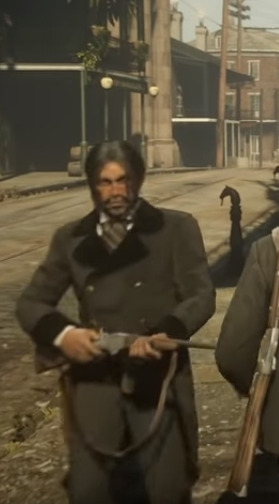
A classic suit with just a touch of more. A wide velvet collar with matching velvet cuffs create a refined softness, contrasting the gold buttons and dramatic coattails. Shoes shiny. Skin moisturized. Even his everyday ponytail looks fancier than ever. 15/10, if Javier kicked over my sandcastle I’d thank him
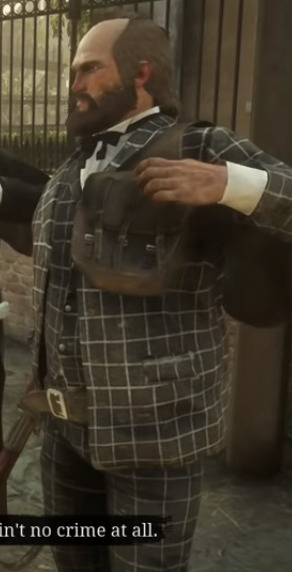
What are those????????? I think Bill got pranked by Uncle while out shopping for robbery gear. That, or he confused one of Susan’s tablecloths for a three-piece. The topmost layer of dust is so thick it could be peeled off and donated to charity. 3/10, could probably still pass for a picnic table
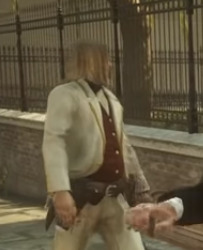
Shameless. Unacceptable. Walking around like a bootleg Egoraptor with a crinkly suit that looks like that oil-stained pizza napkin you keep forgetting to toss. Why did I take a screencap that makes it look like Dutch is jacking him off. Micah’s even jutting his beer gut out in an ominous foreshadowing for the Guarma chapter. ThereIsn’tANumberLowEnough/10
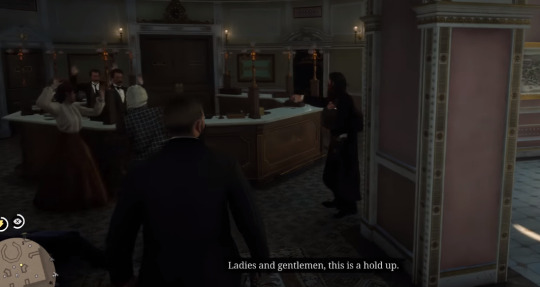
Arthur strolling in with that slow, confident walk that gets me pregnant in both legs, someone please fetch the plan B
Dutch calls a Hosea an artist and is most certainly one himself. He speaks with the affect of a poet, even as he’s holding a pistol in people’s faces and making them shit themselves in slow-motion. This man redefines stage presence. Why would he want anything less than the best, when this is the final hurrah of his iconic, infamous career:
THE RUNWAY: PART TWO
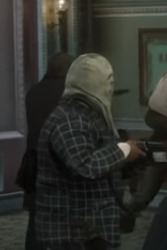
Bill out here just confusing everyone’s laundry for low-level loot. 5/10, may or may not be susan’s granny panties
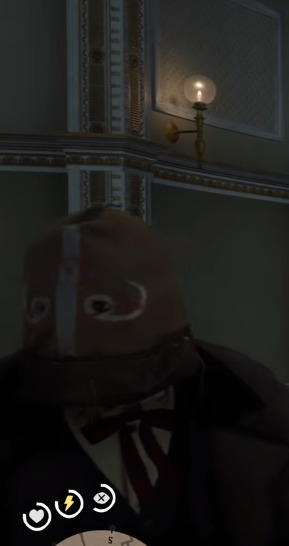
charles: “is my iron giant cosplay valid robbery wear”
dutch: “no, charles, iron giant cosplays are not valid robbery wear”
dutch: “gorons from legend of zelda aren’t valid either”
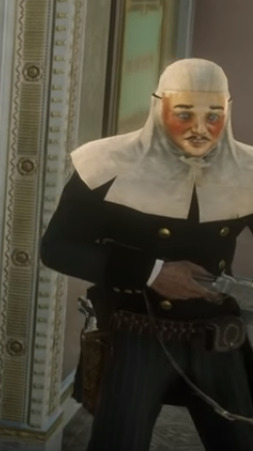
JAVIER IF I GIVE YOU A 10/10 WILL YOU LEAVE
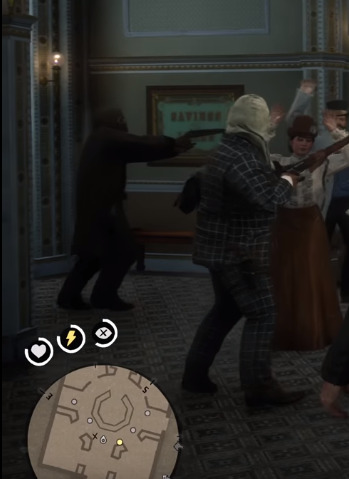
Here’s a little detail I didn’t notice (even after several viewings of this scene): Charles over in the corner looking like a dweeb.
Notice how awkwardly he holds that rifle: two-handed and with his knees bent, suddenly looking like he’s never handled a weapon before. This is such an odd contrast from the unapologetic badass we know. Remember, this is the same man who can wield a sawed-off shotgun one-handed like it’s nothing. One of the most adept physical fighters in a gang full of cutthroat motherfuckers.
This detail on top of his dorky robbery gear? It’s actually a peek into just how out of his element he is.
Charles has been with the gang for less than a year at this point. Even then, he’s usually helping with tracking, hunting and scouting. Whenever he goes off with Arthur on a mission, he’s always the first to suggest a peaceful route. This is not someone who’s used to robbing people for a living and it shows in the most adorable way. What you see here is a man putting on a persona of what he hopes looks like a bloodthirsty robber.
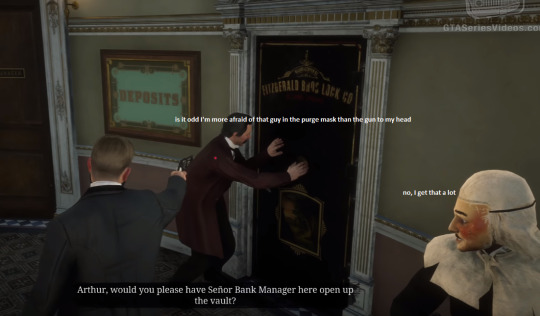
This whole scene is a fucking blast. Herding the upper-class elite into the far rom, figuring out the combination key under codenames, listening to the banter of the squad in the background. It doesn’t help I’m a slut for baroque-styled architecture and half my attention was on the pastel decor. Yeah, yeah, I know we have three thousand dollars on the line, but look at that gold filigree
These outlaws move like a finely oiled machine, not a detail out of place...which makes the ensuing mess all the more tragic.
...and this post is getting too long, so I’m going to post the second part separately. Ain’t I a stinker?
#red dead redemption#red dead redemption 2#RDR#RDR2#arthur morgan#john marston#dutch van der linde#javier escuella#bill williamson#hosea matthews#micah bell#charles smith#shitpost#analysis#TEDTalk#meme#my post#I want to see javier preparing that outfit at the camp#just adding blush to his mask and making tilly double-take while eating her stew
382 notes
·
View notes
Text
Cinema Variety’s Top 25 Favorite Films of the Decade
This past decade has been a monumental ten years for the state of cinema. To think that there were actually still video rental stores all around the country, to almost becoming nonexistent, is statement enough to show how vastly audiences have changed the way they consume media. Through much thought and careful deliberation, the following 25 films are my personal favorites of the decade and are what I think best represent all that indie, international and arthouse cinema had to offer over the past ten years. Honorable Mentions: Shame Green Room A Ghost Story The Lost City of Z Knight of Cups 20th Century Women Jackie Blade Runner 2049 The Lighthouse Ingrid Goes West A Hidden Life
#25 - Suspiria (2018) Dir. Luca Guadagnino
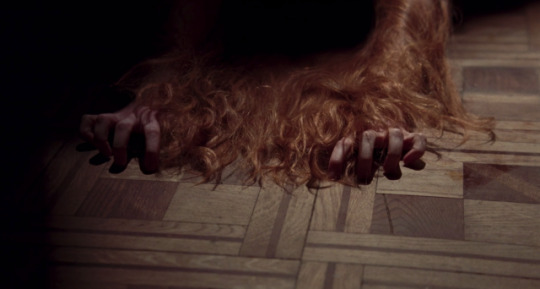
“It’s only hours afterward that Guadagnino’s film will cohere for you and yield its buried treasures: the bonds of secret sorority, the strength of a line of dancers moving like a single organism, the present rippling with the muscle memory of the past. It’s so good, it’s scary.���
#24 - Call Me By Your Name (2017) Dir. Luca Guadagnino
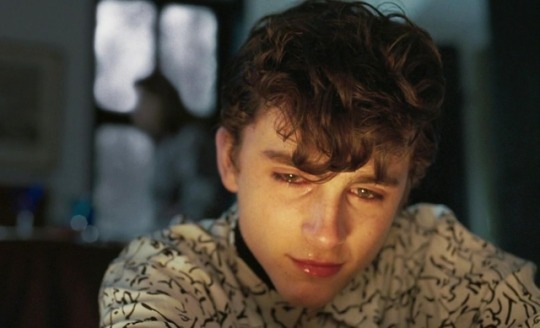
“The final beats of Guadagnino’s adaptation galvanize two hours of simmering uncertainty into a gut-wrenchingly wistful portrait of two people trying to find themselves before it’s too late.”
#23 - American Honey (2016) Dir. Andrea Arnold

“Part dreamy millennial picaresque, part distorted tapestry of Americana and part exquisitely illustrated iTunes musical, “Honey” daringly commits only to the loosest of narratives across its luxurious 162-minute running time. Yet it’s constantly, engrossingly active, spinning and sparking and exploding in cycles like a Fourth of July Catherine wheel.”
#22 - Post Tenebras Lux (2013) Dir. Carlos Reygadas
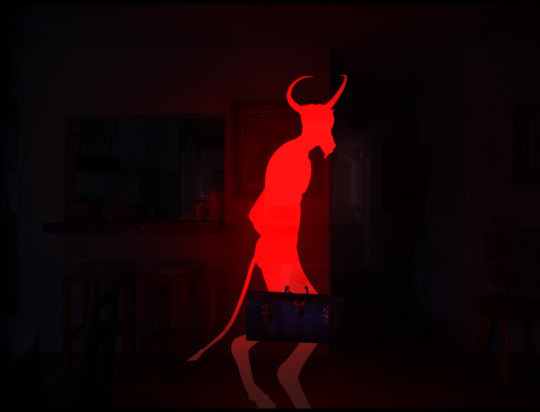
“Some metaphors score and some miss, but this is leap-of-faith cinema: the rewards entail some risks.”
#21 - The Revenant (2015) Dir. Alejandro G. Iñárritu

“Pushing both brutal realism and extravagant visual poetry to the edges of what one customarily finds in mainstream American filmmaking, director/co-writer Alejandro G. Inarritu, cinematographer Emmanuel Lubezki and a vast team of visual effects wizards have created a sensationally vivid and visceral portrait of human endurance under very nearly intolerable conditions.”
#20 - Her (2013) Dir. Spike Jonze
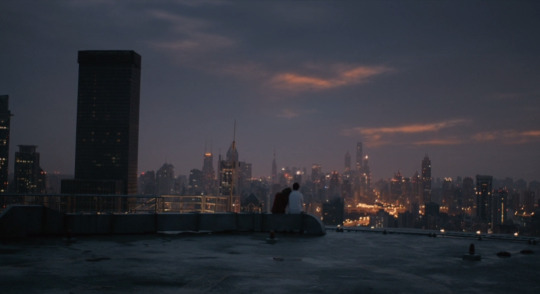
“What begins like an arrested adolescent dream soon blossoms into Jonze’s richest and most emotionally mature work to date, burrowing deep into the give and take of relationships, the dawning of middle-aged ennui, and that eternal dilemma shared by both man and machine: the struggle to know one’s own true self.”
#19 - Annihilation (2018) Dir. Alex Garland

“A shimmering example of what Hollywood sci-fi can achieve when the aim is high, Annihilation is a gripping, mystifying adventure and proof that a transportive experience is more rewarding than a story with clean-cut resolutions.”
#18 - The Neon Demon (2016) Dir. Nicolas Winding Refn

“Spectacular, gross and delicious (so unsavory it’s almost sweet), the film is more proof of Refn’s mastery of his trash aesthetic and more fun than anything this indulgent and empty-headed has any right to be.”
#17 - Waves (2019) DIr. Trey Edward Shults

“Propelled by color, energy, electronic music and a quartet of career-making performances, here is that rare sort of cinematic achievement that innovates at every turn, while teaching audiences how to make intuitive sense of the way it pushes the medium.”
#16 - Mother! (2017) Dir. Darren Aronofsky
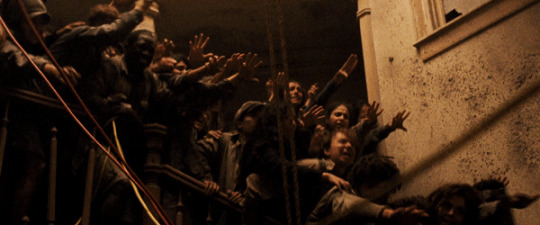
“Mother! is something truly magnificent, the kind of visceral trash-arthouse experience that comes along very rarely, means as much or as little as you decide it does, and spits you out into the daylight dazzled, queasy, delirious, and knock-kneed as a newborn calf.”
#15 - Melancholia (2011) Dir. Lars Von Trier

“The vision is as hateful as it is hate-filled, but the fusion of form and content is so perfect that it borders on the sublime. Melancholia is a remarkable mood piece with visuals to die for (excuse the pun), and a performance from Dunst that runs the color spectrum of emotions.”
#14 - Song to Song (2017) Dir. Terrence Malick
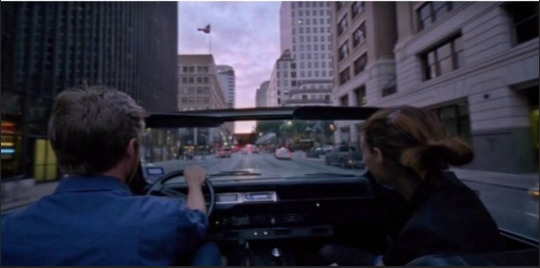
“Any number of sequences find feelings both externalized and hidden intermingling within the same shot, continuing in a subsequent image that carries the impression, the feeling, without replicating the exact tenor of what has just been seen. They exist simultaneously as certain backstories and what motivations they may inspire delicately unfold. Malick has found a way to translate how a familiar song has the ability to transport you back to a particular time and conjure a specific set of emotions. Whatever he’s been exploring over the past few years pays off here.”
#13 - If Beale Street Could Talk (2018) Dir. Barry Jenkins
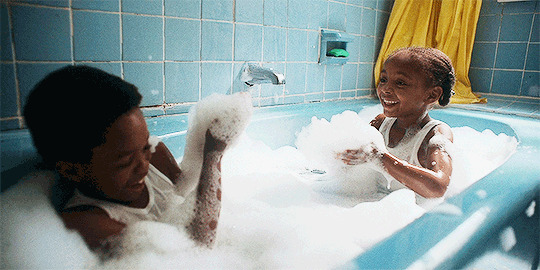
“What Jenkins gets most right—what astonishes me the most about this film—is Baldwin’s vast affection for the broad varieties of black life. It’s one of the signature lessons of Baldwin’s work that blackness contains multitudes. In some ways Beale feels less like a movie than a well-staged, meticulously shot play; a period piece that floats beyond its specific time and place and into the realm of allegory.”
#12 - Samsara (2012) Dir. Ron Fricke

“Simply put, Samsara tells the story of our world, but onscreen, it is so much more than that. A darker and more ambitious meditation on impermanence, Samsara relies on blunt force and unforgettable imagery, overcoming the hazy logic of Fricke's editing to earn your awe.”
#11 - It’s Such a Beautiful Day (2012) Dir. Don Hertzfeldt
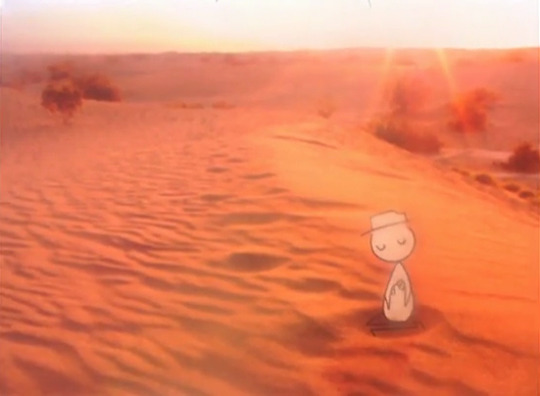
“A highly original and utterly enthralling film that touches on staggeringly expansive themes - more typically expected in the work of master auteur and persistent award-winner Terrence Malick, than from animations. An existential flipbook and a heartbreaking black joke: stickmen have never looked so alive.”
#10 - Upstream Color (2013) Dir. Shane Carruth
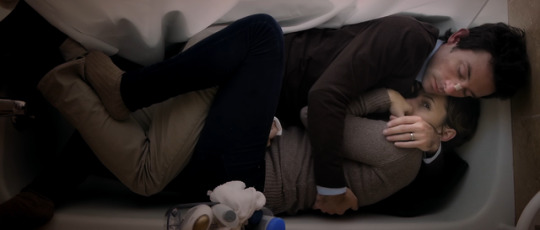
“You may not be able to figure it out, but that's part of the point of this sensually-directed, sensory-laden experiential (and experimental) piece of art that washes over you like a sonorous bath of beguiling visuals, ambient sounds and corporeal textures.”
#9 - Hereditary (2018) Dir. Ari Aster
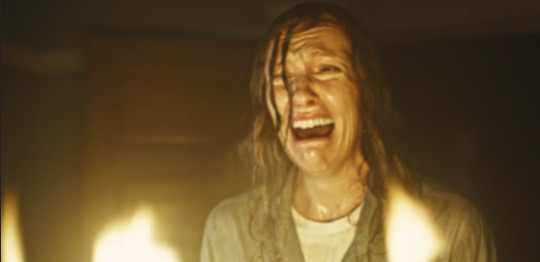
“It’s a supremely effective gauntlet of supernatural horror that’s also, at blackened heart, a grueling domestic drama about how trauma, resentment, and guilt can seep into the roots of a family tree, rotting it from the inside out.”
#8 - Spring Breakers (2013) Dir. Harmony Korine

“Spring Breakers seems to be holding a funhouse mirror up to the face of youth-driven pop culture, leaving us uncertain whether to laugh, recoil in horror, or marvel at its strange beauty. Full credit to Korine, who sustains this act of creative vandalism right through to the finish. Spring Breakers unfolds as a fever dream of teenage kicks, a high-concept heist movie with mescal in the fuel tank.”
#7 - The Master (2012) Dir. Paul Thomas Anderson
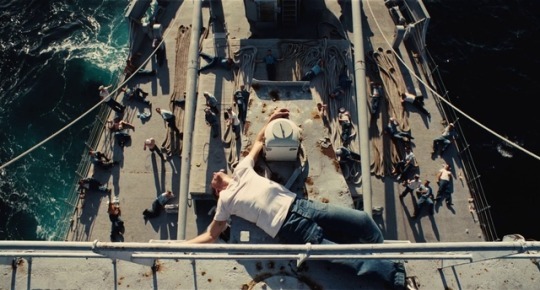
“Two things stand out: the extraordinary command of cinematic technique, which alone is nearly enough to keep a connoisseur on the edge of his seat the entire time, and the tremendous portrayals by Joaquin Phoenix and Philip Seymour Hoffman of two entirely antithetical men. Written, directed, acted, shot, edited and scored with a bracing vibrancy that restores your faith in film as an art form, The Master is nirvana for movie lovers. Anderson mixes sounds and images into a dark, dazzling music that is all his own.”
#6 - Interstellar (2014) Dir. Christopher Nolan
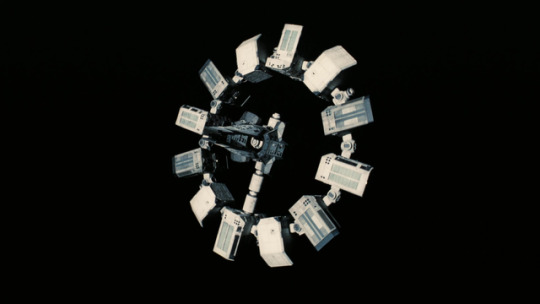
“It’s a bold, beautiful cosmic adventure story with a touch of the surreal and the dreamlike, and yet it always feels grounded in its own deadly serious reality. An exhilarating slalom through the wormholes of Christopher Nolan’s vast imagination that is at once a science-geek fever dream and a formidable consideration of what makes us human.”
#5 - The Place Beyond the Pines (2013) Dir. Derek Cianfrance
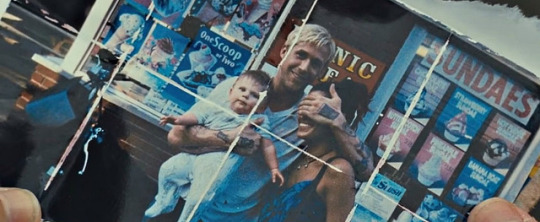
“A brilliant, towering picture, The Place Beyond The Pines is a cinematic accomplishment of extraordinary grace and insight. The movie succeeds both as a high-stakes crime thriller as well as a far quieter and empathetic study of angry, solitary men proves that Cianfrance has a penchant for bold storytelling and an eye for performances to carry it through.”
#4 - Black Swan (2010) Dir. Darren Aronofsky
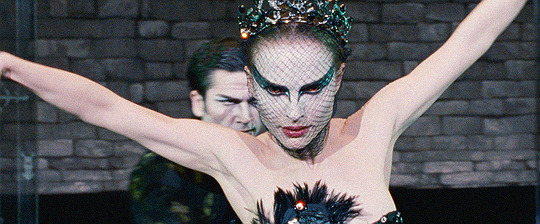
“A full-bore melodrama, told with passionate intensity, gloriously and darkly absurd. It centers on a performance by Natalie Portman that is nothing short of heroic. This is, no doubt about it, a tour de force, a work that fully lives up to its director's ambitions.”
#3 - Drive (2011) Dir. Nicolas Winding Refn
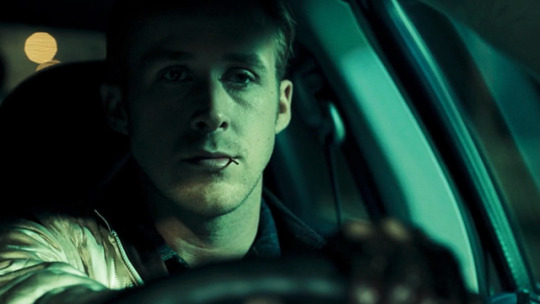
“From the beginning, it's clear this is not a standard-order action film. It takes its characters as seriously as its chases, shootouts, and fights. Drive dynamically merges a terrific film noir plot with a cool retro look. It's an unapologetically commercial picture that defies all the current trends in mainstream action filmmaking.”
#2 - Blue Valentine (2010) Dir. Derek Cianfrance
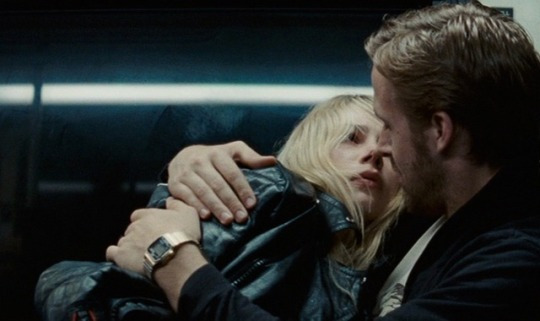
“Cianfrance and his actors, Michelle Williams and Ryan Gosling, have not made a cold or schematic film. They aim instead for raw emotional experience, one that's full of insight into the ways a relationship can go astray, but mostly feels like a slow-motion punch to the gut.”
#1 - The Tree of Life (2011) Dir. Terrence Malick
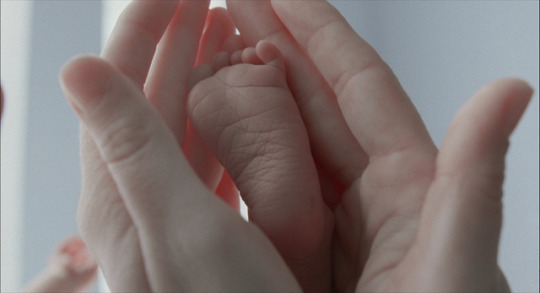
"The Tree of Life is a film of vast ambition and deep humility, attempting no less than to encompass all of existence and view it through the prism of a few infinitesimal lives. I wrote earlier about the many ways this film evoked my own memories of such time and place. About wide lawns. About a town that somehow, in memory, is always seen with a wide-angle lens. About houses that are never locked. About mothers looking out windows to check on their children. About the summer heat and ennui of church services, and the unpredictable theater of the dinner table, and the troubling sounds of an argument between parents, half-heard through an open window.”
#favorite films of the decade#best films of the decade#decade in review#favorite films#shame#steve mcqueen#green room#jeremy saulnier#a ghost story#david lowery#the lost of city#james gray#knight of cups#terrence malick#20th century women#mike mills#jackie#pablo lorraine#blade runner 2049#denis villeneuve#the lighthouse#robert eggers#ingrid goes west#a hidden life#suspiria#luca guadagnino#call me by your name#american honey#andrea arnold#post tenebras lux
128 notes
·
View notes
Text
Matrix Pill 2020
The Matrix has you…
The cultural overview over "The Matrix Trilogy" and how it foresaw the social trends.
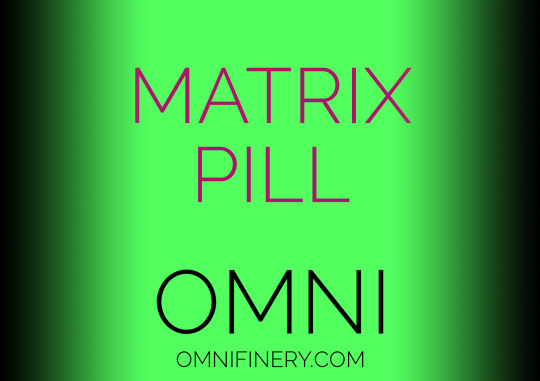
"The Matrix" trilogy by the Wachowski brothers is the most iconic and groundbreaking movie trilogies in cinema history. Terms like "The red pill", "Dessert of the real", "There is no spoon", "Follow the white rabbit", "Why, Mr. Anderson? Why?" and many other phrases from the film became the golden quotes of the new millennium, shaping the entire culture of the "generation Y"… also known as "the millennials". "The bullet time" effect with fancy acrobatic moves and bullet waves turned into the most quoted gimmick for decades in action films, parodies and video games. The slow motion has never been so cool and slick, as it was after "The Matrix", not to mention sunglasses at night and dark looks with fashionable black leather tailored coats.
Its been 21 years since the theatrical release of the first "The Matrix" film. It came out in November of 1999 (the most revolutionary year in cinema history, since it is the release year of such groundbreaking hit titles like "Star Wars: Episode I. The Phantom Menace" by George Lucas, "Fight Club" by David Fincher, and "The Matrix", of course, by the Wachowski brothers). Four years after the great success of the film, "The Matrix" was reloaded with two worthy sequels: "The Matrix Reloaded" and "The Matrix Revolutions" — turning a movie franchise into a full-time trilogy. There was also "The Animatrix" — an anthology of animated short films set in "The Matrix Universe" directed by highly acclaimed Japanese animators, and a video-game "Enter the Matrix" which told a story that went parallel to the story of sequels, explaining some of the unanswered questions in the films. Thus "The Matrix" franchise has become one of the first inter-media franchises where all available storytelling formats told one epic story from different angles and points of view. And unlike other attempts of creating such inter-media franchise around movies (like it was with "Star Wars Expended Universe" or "The Terminator" franchise) it wasn't just pure merchandising and cash-grabbing schemes with questionable product quality having a famous brand logo on it… no, '"The Matrix" franchise was one well thought out project and story from the very beginning, created and curated by the Wachowski brothers. Nothing more or less.
In the year of 2020 "The Matrix" is being reloaded once again with its new instalment being in production. Internet is filled with shaky mobile phone behind the scenes footage of "The Matrix 4". We see Neo, played by actor Keanu Reeves and his stunt double, jumping of high buildings and riding fancy motorcycle with Trinity, played by Carrie Ann-Moss, while the streets of San-Francisco are being turned into a chaotic war zone with explosions, car chases, extras running all over the streets and helicopters flying.
Usually such big blockbuster film productions are being held in secret in order to prevent unnecessary leaks and story spoilers… most of the extras and crew members don't even know what movie they are filming up until the very end. During such big productions fake movie titles are made. But this time, as it seams, filmmakers don't really care about production secrecy, as actor Keanu Reeves and film director Lana Wachowski keep on hanging out with random people on a street during the filmmaking process. What is it? A new viral social media format of film advertising? Or the new way of entire filmmaking approach? Or maybe both?
Either way — Lana Wachowski is the visionary artist that is going to bring something fresh and unexpected into the cinema format and into the new "Generation Z" culture. The Wachowski brothers have foreseen the future with "The Matrix" film almost in every way possible… and I'm pretty sure they are going to do so again. They spoke of cyber-crimes, data privacy and internet control long before Edward Snowden incident, WikiLeaks, Anonymous group, social medias and etc. They showed aircraft controlled by so called "terrorists" hitting skyscrapers years before 9/11. "The Matrix" also tried to warn us about the dangers of virtual realities, and here we are 20 years later using VR systems and spending our lives in endless MMO RPG games (by the way, "The Matrix" franchise even had its own MMO RPG video game "The Matrix Online"). The virtual values have become much more valuable that the material ones. Bitcoins and Facebook likes are considered to be much more precious then real money and even gold by many. Instagram pages are viewed as the only true portraits of their users, however bright filters, happy faces, flattering camera lenses and photoshop have nothing to do with reality. It is merely a "Residual self-image", as it was named in the film, "A mental projection of your digital self". The person sees himself whom he wants him to be, not whom he really is.
And I think that this topic is the most overlooked topic by critics and contemporary culture scholars.
Just think about it — the Wachowski brothers are the physical manifestation of their own concept of "Residual self-image", as both of them saw themselves as someone different. Both brothers were men, but they considered themselves to be women. Their physical reality didn't match with their mental projection of virtual self. Thus they had to do surgeries and go through sex change procedures. The Wachowski brothers are officially sisters. Nowadays in 2020 it is a common practice that can't surprise anyone, however in 1990s during the production of the first "The Matrix" film it was a big deal… so big that Wachowski brothers had to rewrite the screenplay. In the earlier drafts of the script there was a fully flashed out transgender character. She is still present in the final film, but her role and concept has been reduced. Character Switch — portrayed by Belinda McClory — was a transgender, and her name "Switch" meant too illustrate her constant transitions from one form into another, as she was a female in the real world, but in the Matrix her personal "Residual self-image" switched her into a masculine male. For Wachowski brothers it was a very important topic to explore, since both of them dedicated their lives to transgender worldview, but in 1990's the film studio and producers thought that such concepts would be too confusing for average film viewers and difficult to follow, thus it was all cut out during pre-production. Even their first film "Bound" that featured lesbian love story was met with numerous misunderstandings during pre-production, during its filming and, of course, during its release, since such themes were considered too risky… almost taboo, as they could easily put off many unprepared audiences.
But now… look how the world and culture has changed?! In 21 years everything is upside down. It is almost impossible to find a big blockbuster film or franchise or T.V. series or even a video-game that has no lesbian, gay, transgender, bisexual, pansexual or any other "something"-sexual character. It is true for both "rated R" and "rated M" media and for media oriented for children. Disney's life adaptation of animated classic "Beauty and the Beast" is the prime example… not to mention more.
I must say that unorthodox sexual orientation of characters were always present in cinema, they were never the subject of prohibition and never will be, however before "Wachowski era" their orientation always played some sort of narrative purpose. No character was supposed to be gay or transexual just for that sake of being such. But nowadays we see LGBT characters all over visual media… and the fact of their orientation rarely enhance the story or add anything to it. For the most part it is just being there for no reason other then being there. No wonder we have so many poorly written stories today. "Chekhov's gun" is the key to good storytelling, isn't it? If you put something into a story, it must heave a purpose, because without purpose it's just a filler, a white noise… this means it shouldn't be there at all. And here I'd like to quote Agent Smith from "The Matrix" films:
"But, as you well know, appearances can be deceiving…" — even here Wachowski brothers point out the previous "Residual self-image" topic. "…which brings me back to the reason why we're here. We're not here because we're free. We're here because we're not free. There is no escaping reason; no denying purpose. Because as we both know, without purpose, we would not exist."
Curious… Wachowski brothers were pioneers in LGBT mass-media, yet even they were smart enough to exclude these themes from "The Matrix trilogy", even having a total creative freedom over the sequels, as they knew that it would serve no purpose in their story. Yet they used much more sophisticated tricks to pinpoint their agenda and worldview. Get ready for some hard drugs! Wachowski brothers urged the protagonist and film viewers to take "The red pill" and "Free our minds". They also urged us to fight against all rules and stereotypes, and young generation loved it. In the film it simply meant "rage against the machines", but in our world where this film was "The red pill" for young people, this fight against the established order had much deeper purpose.
Upon the quick view on the lives of the Wachowski brothers over these two decades we can tell that their "red pill" they were giving us, was simply a androgyne hormone for transgenders and their main "Matrix" they were fighting against, was the sexual orientation stereotypes. They succeeded in their revolution, as LGBT themes are no longer taboo in mass-media. But there were also other important cultural topics Wachowski brothers presented with their trilogy: multiculturalism, racial diversity, feminism and even "toxic masculinity" and war against white men and patriarchy… long before these themes became mainstream in pop-culture.
"The Matrix" franchise had always a diverse cast, didn't it? It also has strong and independent female characters right from the start. And it wasn't just a copycat trend to appeal some social minorities, as it happens today. It was the personal philosophy of the authors. However, despite all their diversity and equality, one social group was shown deliberately one-sided. Just think about it. All evil characters in all three films were male and white. Agents are white middle aged men, Cypher — white middle aged man, Merovingian — white middle aged man, Architect — white man, Bane — white middle aged man, etc. Some can argue on this topic, since white men where also on the side of good guys. True, "but, as you well know, appearances can be deceiving…" says Smith. All white men on the good side of the story are… well, questionable. Whom can we name? Councillor Hamann — played by Anthony Zerbe — is a white man… a father figure in Zion, however he is shown to be an irrational and rhetorical weak old man. Comparing him to other leaders of Zion we can easily see his incompetence. Even Neo makes fun of him, pointing out on a fact that Hamann's solid age doesn't make him wiser (and it is the only time in the whole trilogy when the main protagonist ever trolls anyone). Then there is the Kid — played by Clayton Watson — another white man good guy, but he is just an immature naive boy… in "The Animatrix" he in the moment of danger finds no better way out then a suicide… a very questionable role model, don't you think? Who's next? Mouse — portrayed by Matt Doran — once again a young teenager full of sexual hormones and nothing more. There is also Captain Roland — played by David Roberts — and his ship crew, but a single black woman Niobe — played by Jada Pinkett Smith — turns out to be wiser and much more competent then any of them. Meanwhile all non-white and non-male characters are shown in the positive light. Wait… but what about Neo — the one himself — played by Keanu Reeves — he is a white man — the hero of the trilogy. True. However originally "The Matrix" creators wanted to cast Will Smith for the role of Neo, but Will Smith declined the role and chose to act in "Wild Wild West".
In other words Wachowski brothers brought up anti-white men SJW themes in their films long before such topics became mainstream and part of pop-culture. Thus they weren't even noticed by the time of film release. But it is worth mentioning that Wachowski brothers were depicting anti-white men subplots not because they were following some kind of fashion or social agenda like mass-media does today, but because brothers WERE white and men, and they wanted to do something about it. And they did. For real.
However next generation of filmmakers and artists took the Wachowski brothers' personal issues and turned it into a viral trend, changing the culture forever. It can be even said that the modern SJW and LGBT hysteria is the Matrix, created by Wachowski brothers. I wonder, will their new "The Matrix" film change the world once again?.. and how?
Text: Jurii Kirnev
Omnifinery Editorial: Article 003
2 notes
·
View notes
Text
It’s been a whole year since I posted last. Part of me wants to apologise for being gone so long, but mostly I’m just glad that I’m here.
Instead of doing a GIANT 2018 READING POST, I’m going to chop it up into three posts:
Favourite Books Read in 2018
2018 Reading Data and Goal-setting for 2019
2013-2018 Reading Data Trends
I was going to do a bigass one like I usually do but it just felt so daunting. Probably because I read 256 books in 2018 and it was pretty tempting to just close that Excel sheet and move on to an empty one for 2019. But what is the point of an unexamined life, anyway?
So this post is basically a listicle with summaries grabbed from Goodreads, as well as the complete list of the books I read in 2018. I really enjoyed all these books immensely and they’re all in my personal canon now.
My Top 10 Reads for 2018:
The Odyssey by Homer, translated by Emily Wilson
The first great adventure story in the Western canon, The Odyssey is a poem about violence and the aftermath of war; about wealth, poverty, and power; about marriage and family; about travelers, hospitality, and the yearning for home.In this fresh, authoritative version—the first English translation of The Odyssey by a woman—this stirring tale of shipwrecks, monsters, and magic comes alive in an entirely new way. Written in iambic pentameter verse and a vivid, contemporary idiom, this engrossing translation matches the number of lines in the Greek original, thus striding at Homer’s sprightly pace and singing with a voice that echoes Homer’s music.
Circe by Madeline Miller
In the house of Helios, god of the sun and mightiest of the Titans, a daughter is born. But Circe is a strange child—not powerful, like her father, nor viciously alluring like her mother. Turning to the world of mortals for companionship, she discovers that she does possess power—the power of witchcraft, which can transform rivals into monsters and menace the gods themselves.Threatened, Zeus banishes her to a deserted island, where she hones her occult craft, tames wild beasts and crosses paths with many of the most famous figures in all of mythology, including the Minotaur, Daedalus and his doomed son Icarus, the murderous Medea, and, of course, wily Odysseus.But there is danger, too, for a woman who stands alone, and Circe unwittingly draws the wrath of both men and gods, ultimately finding herself pitted against one of the most terrifying and vengeful of the Olympians. To protect what she loves most, Circe must summon all her strength and choose, once and for all, whether she belongs with the gods she is born from, or the mortals she has come to love.
3. The World of the Five Gods by Lois McMaster Bujold
A man broken in body and spirit, Cazaril, has returned to the noble household he once served as page, and is named, to his great surprise, as the secretary-tutor to the beautiful, strong-willed sister of the impetuous boy who is next in line to rule.
It is an assignment Cazaril dreads, for it will ultimately lead him to the place he fears most, the royal court of Cardegoss, where the powerful enemies, who once placed him in chains, now occupy lofty positions. In addition to the traitorous intrigues of villains, Cazaril and the Royesse Iselle, are faced with a sinister curse that hangs like a sword over the entire blighted House of Chalion and all who stand in their circle. Only by employing the darkest, most forbidden of magics, can Cazaril hope to protect his royal charge—an act that will mark the loyal, damaged servant as a tool of the miraculous, and trap him, flesh and soul, in a maze of demonic paradox, damnation, and death
4. Noli Me Tangere by Jose Rizal, Translated by Harold Augenbraum
In more than a century since its appearance, José Rizal’s Noli Me Tangere has become widely known as the great novel of the Philippines. A passionate love story set against the ugly political backdrop of repression, torture, and murder, “The Noli,” as it is called in the Philippines, was the first major artistic manifestation of Asian resistance to European colonialism, and Rizal became a guiding conscience—and martyr—for the revolution that would subsequently rise up in the Spanish province.
5. America is Not The Heart by Elaine Castillo
Three generations of women from one immigrant family trying to reconcile the home they left behind with the life they’re building in America.
How many lives can one person lead in a single lifetime? When Hero de Vera arrives in America, disowned by her parents in the Philippines, she’s already on her third. Her uncle, Pol, who has offered her a fresh start and a place to stay in the Bay Area, knows not to ask about her past. And his younger wife, Paz, has learned enough about the might and secrecy of the De Vera family to keep her head down. Only their daughter Roni asks Hero why her hands seem to constantly ache.
Illuminating the violent political history of the Philippines in the 1980s and 1990s and the insular immigrant communities that spring up in the suburban United States with an uncanny ear for the unspoken intimacies and pain that get buried by the duties of everyday life and family ritual, Castillo delivers a powerful, increasingly relevant novel about the promise of the American dream and the unshakable power of the past. In a voice as immediate and startling as those of Junot Diaz and NoViolet Bulawayo, America Is Not the Heart is a sprawling, soulful telenovela of a debut novel. With exuberance, muscularity, and tenderness, here is a family saga; an origin story; a romance; a narrative of two nations and the people who leave home to grasp at another, sometimes turning back.
6. The Feather Thief: Beauty, Obsession, and the Natural History Heist of the Century by Kirk W. Johnson
A rollicking true-crime adventure and a thought-provoking exploration of the human drive to possess natural beauty for readers of The Stranger in the Woods, The Lost City of Z, and The Orchid Thief.
On a cool June evening in 2009, after performing a concert at London’s Royal Academy of Music, twenty-year-old American flautist Edwin Rist boarded a train for a suburban outpost of the British Museum of Natural History. Home to one of the largest ornithological collections in the world, the Tring museum was full of rare bird specimens whose gorgeous feathers were worth staggering amounts of money to the men who shared Edwin’s obsession: the Victorian art of salmon fly-tying. Once inside the museum, the champion fly-tier grabbed hundreds of bird skins–some collected 150 years earlier by a contemporary of Darwin’s, Alfred Russel Wallace, who’d risked everything to gather them–and escaped into the darkness.
Two years later, Kirk Wallace Johnson was waist high in a river in northern New Mexico when his fly-fishing guide told him about the heist. He was soon consumed by the strange case of the feather thief. What would possess a person to steal dead birds? Had Edwin paid the price for his crime? What became of the missing skins? In his search for answers, Johnson was catapulted into a years-long, worldwide investigation. The gripping story of a bizarre and shocking crime, and one man’s relentless pursuit of justice, The Feather Thief is also a fascinating exploration of obsession, and man’s destructive instinct to harvest the beauty of nature.
7. Educated: A Memoir by Tara Westover
An unforgettable memoir in the tradition of The Glass Castle about a young girl who, kept out of school, leaves her survivalist family and goes on to earn a PhD from Cambridge University
Tara Westover was 17 the first time she set foot in a classroom. Born to survivalists in the mountains of Idaho, she prepared for the end of the world by stockpiling home-canned peaches and sleeping with her “head-for-the-hills bag”. In the summer she stewed herbs for her mother, a midwife and healer, and in the winter she salvaged in her father’s junkyard.
Her father forbade hospitals, so Tara never saw a doctor or nurse. Gashes and concussions, even burns from explosions, were all treated at home with herbalism. The family was so isolated from mainstream society that there was no one to ensure the children received an education and no one to intervene when one of Tara’s older brothers became violent.
Then, lacking any formal education, Tara began to educate herself. She taught herself enough mathematics and grammar to be admitted to Brigham Young University, where she studied history, learning for the first time about important world events like the Holocaust and the civil rights movement. Her quest for knowledge transformed her, taking her over oceans and across continents, to Harvard and to Cambridge. Only then would she wonder if she’d traveled too far, if there was still a way home.
Educated is an account of the struggle for self-invention. It is a tale of fierce family loyalty and of the grief that comes with severing the closest of ties. With the acute insight that distinguishes all great writers, Westover has crafted a universal coming-of-age story that gets to the heart of what an education is and what it offers: the perspective to see one’s life through new eyes and the will to change it.
8. The Wicked + The Divine, Vol. 7 and 8 by Kieron Gillen, Stephanie Hans, André Lima Araújo, Matt Wilson, Kris Anka, Jen Bartel
In the past: awful stuff. In the present: awful stuff. But, increasingly, answers.
Modernist poets trapped in an Agatha Christie Murder Mystery. The Romantics gathering in Lake Geneva to resurrect the dead. What really happened during the fall of Rome. The Lucifer who was a nun, hearing Ananke’s Black Death confession. As we approach the end, we start to see the full picture. Also includes the delights of the WicDiv Christmas Annual and the Comedy special.
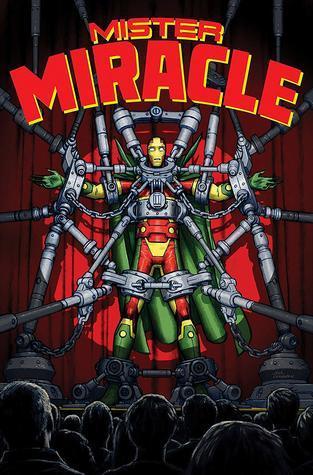
9. Mister Miracle by Tom King and Mitch Gerads
Mister Miracle is magical, dark, intimate and unlike anything you’ve read before.
Scott Free is the greatest escape artist who ever lived. So great, he escaped Granny Goodness’ gruesome orphanage and the dangers of Apokolips to travel across galaxies and set up a new life on Earth with his wife, Big Barda. Using the stage alter ego of Mister Miracle, he has made quite a career for himself showing off his acrobatic escape techniques. He even caught the attention of the Justice League, who has counted him among its ranks.
You might say Scott Free has everything–so why isn’t it enough? Mister Miracle has mastered every illusion, achieved every stunt, pulled off every trick–except one. He has never escaped death. Is it even possible? Our hero is going to have to kill himself if he wants to find out.
10. The Band, #1–2
Clay Cooper and his band were once the best of the best — the meanest, dirtiest, most feared crew of mercenaries this side of the Heartwyld.
Their glory days long past, the mercs have grown apart and grown old, fat, drunk – or a combination of the three. Then an ex-bandmate turns up at Clay’s door with a plea for help. His daughter Rose is trapped in a city besieged by an enemy one hundred thousand strong and hungry for blood. Rescuing Rose is the kind of mission that only the very brave or the very stupid would sign up for.
It’s time to get the band back together for one last tour across the Wyld.
PHEW. Did you guys read any of those books? Did you like them? Hit me up!
The books I read in 2018:
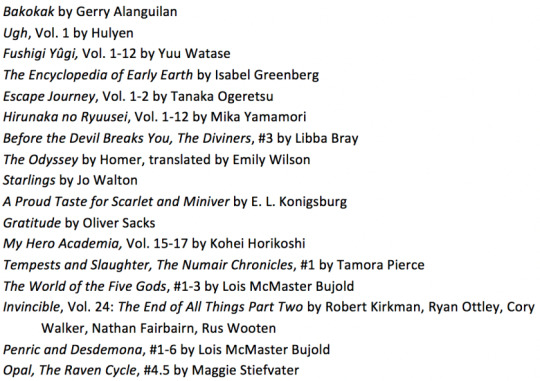
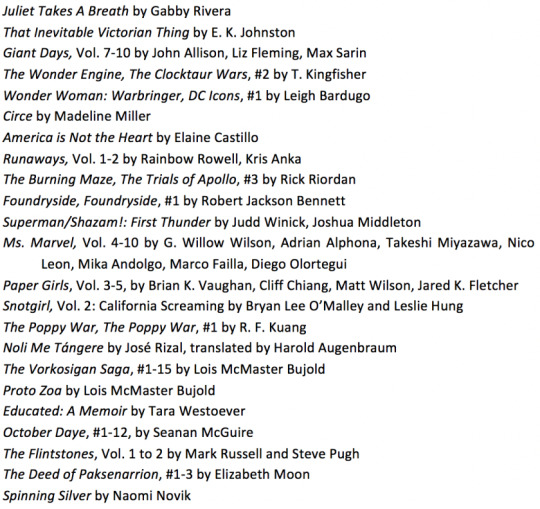
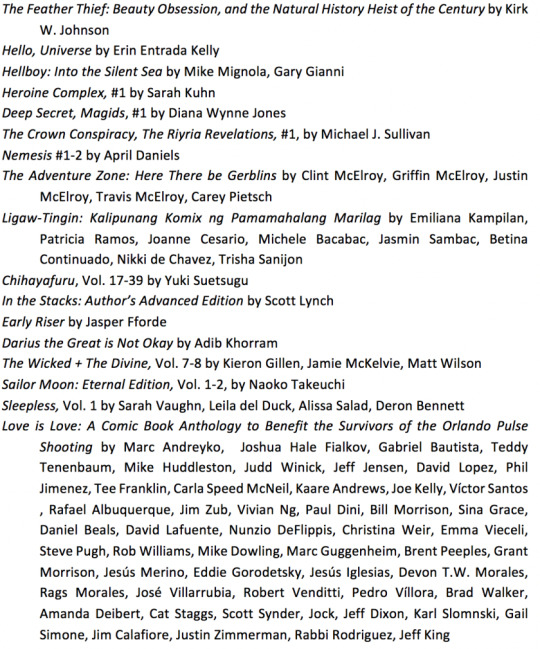

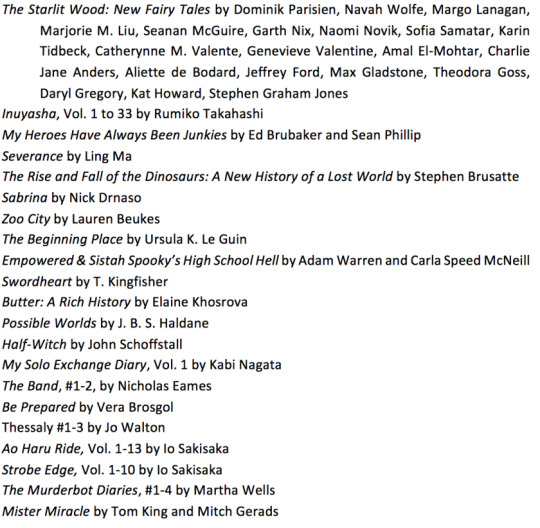
Okay, thank you for reading. Keep a weather eye out for the next post, hopefully very soon.
My Ten Favourite Books from 2018 It's been a whole year since I posted last. Part of me wants to apologise for being gone so long, but mostly I'm just glad that I'm here.
2 notes
·
View notes
Note
Any thoughts on Childish Gambino's "This is America"?
Judging it just as a song, without the video, it’s terrible. Watching its mediocracy get gushed over kind of reminds me of the Obama portraits or those who gave Black Panther a standing ovation before it even started. This willingness to effusively praise anything black artists do dramatically drops the standards of excellence. But art and music is subjective and people can like whatever they want so I won’t go on bashing the song. It’s the video after all that everyone is talking about. To be fair, it’s pretty cool.
The reaction though has been less about it being a song and more about it being some groundbreaking, genius political statement. Every person seems to have formed a different interpretation of the video, but the one that most appear settled on is that it supposedly highlights America’s blindness to the atrocities being committed against blacks - especially by cops and big racist America.
I certainly hope that’s not the message Donald Glover intended as all this does is feed into the overwhelming cycle of misinformation and suppression of facts surrounding the perpetrators and victims of crime.
In 2016, 19 unarmed blacks were shot by police officers. In the same year, 70 police officers were killed by shooting, stabbing, strangulation and beating. We know almost half of the perpetrators in police murders are black, despite being 13 percent of the population. Police officers are at greater risk from blacks than unarmed blacks are from the police, so do we call this a black war against the police?
What’s more interesting is black officers in the New York Police Department were found to be 3.3 times more likely than white officers to use their gun at shooting scenes. Another study of the Philadelphia Police Department found that black and Hispanic officers were more likely than white officers to shoot unarmed blacks under the mistaken belief that those individuals were armed. Black police officers weren’t only more likely to shoot black suspects but also unarmed whites as well. The most expansive investigation in the nation’s history to rein in alleged unconstitutional behavior of its officers comes from Detroit Police Department - where two-thirds of its force is black.
Blacks murdered a thousand more people than any other race in 2013 and in prior years it was much greater, despite making up 13 percent of America. The murder rate among blacks is about as bad as some of the most violent third-world nations. No other racial or ethnic group comes close. Note that for 20 to 24-year-olds, the murder rate among blacks (109.4/100,000) is 17 times higher than the rate for whites (6.4/100,000). Among 15 to 19-year-olds, it is over 20 times higher. The average for all ages is 13 times higher.
Also, black-on-white crime is substantially greater than the reverse despite the claims of oppression and victimization. Black-on-white murder is more than double the rate of white-on-black murder (409 to 189). The same results were found for 2012, 2011, 2010 and prior years. In the other categories of violent crime - rape, robbery and aggravated assault - blacks consistently are largely responsible (40 percent of violent crime at 13 percent of the population) 2013, 2012, 2011, and 2010.
The music video clearly emphasizes America’s gun problem, and it does hint at the Charleston shooting which goes along with the leftist fabrication that the greatest threat to Americans is white guys with guns. While you guys know I’m against guns, the notion that white guys are the perpetrators of gun violence is one hell of a lie. But that doesn’t stop headlines such as “White Men with Guns Are America’s Biggest Terrorists” and “We Have a White People Problem” from entering the mainstream. While journalists, celebrities and activists delight in attacking white male gun owners as fearful and racist, the reality of gun crime in the United States is no different to the color of crime in general - non-white.
In New York City, despite being only about 22 percent of the city’s population, blacks made up a staggering 67.5 percent of shooting arrests in 2016. Hispanics also exceeded their population share, accounting for 29.2 percent of arrests. Despite being almost a third of the city’s population, the figures for whites was 2.3 percent. Blacks also made up 52.4 percent of murders and non-negligent manslaughter. Hispanics accounted for 35.9 percent of arrests for these crimes while whites accounted for less than seven percent of the share.
In Philadelphia, 84 percent of murders are committed with firearms. Blacks make up 44 percent of the population and were responsible for 81.9 percent of the murder in 2015. Whites are 35 percent of the population and committed 17.1 percent of the murders, a number which also included Hispanics. In Milwaukee, the black population is 40 percent, yet blacks accounted for 79 percent of murders in 2016. Whites make up 37 percent of the population yet were responsible for 10 percent. For non-fatal shootings, 88 percent of the perpetrators were black.
In Pittsburgh, just 26 percent of the population is black yet they accounted for a incredible 90.6 percent of the homicides in 2016, which 86.2 percent of the killings were done with a firearm. In Los Angeles, blacks are just 8 percent of the population yet committed 40 percent of the murder in 2017 and 72 percent of murders were by guns. Whites carried out 6 percent while being 30 percent of the Los Angeles population. In New Orleans, blacks make up 60 percent of the population and made up 90 percent of those arrested for murder, which 78 percent used a firearm and blacks also carried out 86 percent of non-lethal shootings.
In Chicago, statistics were called racist for consistently showing the large majority of perpetrators of murder were black so the Chicago Police Department put an end to their annual crime reports in 2011. According to the 2011 report, blacks committed 70.5 percent of the murders, Hispanics 24.3 percent and whites whites 3.5 percent. Chicago is 32 percent black, 32 percent white and 28 percent Hispanic. Blacks and Hispanics also accounted for 96 percent of weapons violation arrests.
And yet, we are told that it’s a racist conspiracy that black people are in prison and it’s white people who are the violent, deadly ones that all minorities have to live in fear of. Grade school kids, especially in inner city neighborhoods are subjected to anti-white racist indoctrination. Students from Booker T. Washington Middle School in Baltimore attended an event titled “Re-Claim, Re-Pair, Re-Form, Re-Produce - REPARATIONS Now!” at Morgan State University. Louis Farrakhan was the keynote speaker. He called whites crackers and told the young audience: “As long as they kill us and go to Wendy’s and have a burger and go to sleep, they’ll keep killing us. But when we die and they die, then soon we’re going to sit at a table and talk about it! We’re tired! We want some of this earth or we’ll tear this goddamn country up!”
So to get back to the music video, if it’s about America’s violent gun culture, then sure, it’s a conversation we all need to have. But if it’s a creative way to reinforce the narrative that blacks are the victims of white men with guns, as so many are adamant it is, then it proves that there’s no medium left untouched by gaslighting idiots and completely fabricated, race-baiting, dividing myths. Young black Americans are already taught by their parents, teachers, media, celebrities and politicians that the greatest threat to them are both cops and white people, having that lie reinforced to them through mainstream music is a disaster. The last thing they need is another dose of angst and victimization.
In all, I don’t enjoy the song, the video is cool and I do like Donald Glover, but the messages in the song are so open to interpretation it’s hard to say if they are constructive or destructive. I guess you gotta appreciate it for that.
62 notes
·
View notes
Photo

Porn’s Harm Is Changing Fast
Skeptics of pornography’s danger point out that porn has been around a long time. After all, the ancient Greeks painted sexual images on their pottery. But comparing paintings on Greek vases to today’s endless stream of live-action, hardcore videos is like comparing apples to…um…kumquats. Technology is changing not only the content of porn, but how, when, and at what age it’s being consumed.
The year was 1953, and Hugh Heffner had just published the first copy of Playboy.
Sex had just started to become a more prominent part of American’s cultural conversation, partly because of Dr. Alfred Kinsey who, five years earlier, had published a controversial but extremely popular book on sexuality. [1] He was heralded as one of the first scientists and writers to talk so openly about sexuality, and his books went flying off the shelves. [2]
Heffner saw a chance to make money from the changing cultural views about sex. But to maximize sales of his new magazine he had to change porn’s image from something your friend’s creepy relative might read to something sophisticated and mainstream. So Heffner put his pornographic photos next to essays and articles written by respected authors. In Playboy, porn started to look like nothing more than harmless pleasure engaged in by respectable and successful individuals.
Flash forward to the 1980s, when VCRs suddenly made it possible for people to watch movies at home. [3] For porn consumers, that meant that instead of having to go to seedy movie theaters on the wrong side of town, they just went to the back room at their local movie rental place. Sure, they still had to go out to find it, but porn was a lot more accessible.
And then the internet changed everything. [4][5]
Once porn hit the Web in the 1990s, suddenly there was nothing but a few keystrokes between anyone with an internet connection and the most graphic material available. [4] The online porn industry exploded. Between 1998 and 2007, the number of pornographic websites grew by 1,800%. [6] By 2004, porn sites were getting three times more visitors than Google, Yahoo!, and MSN Search put together. [7] It was “big business” in a way the world had never seen before. Thirty percent of all internet data was related to porn, [8] and worldwide porn revenues (including internet, sex shops, videos rented in hotel rooms, etc.) grew to exceed the incomes of Microsoft, Google, Amazon, eBay, Yahoo!, Apple, Netflix, and Earthlink combined! [9]
As internet porn grew more popular, it also turned darker, more graphic, and more extreme. (See Why Consuming Porn Is An Escalating Behavior.) With so much porn available, pornographers tried to compete for attention by constantly pushing the boundaries. [10] “Thirty years ago ‘hardcore’ pornography usually meant the explicit depiction of sexual intercourse,” writes Dr. Norman Doidge, a neuroscientist and author of The Brain That Changes Itself. “Now hardcore has evolved and is increasingly dominated by the sadomasochistic themes … all involving scripts fusing sex with hatred and humiliation.” [11] In our post-Playboy world, porn now features degradation, abuse, and humiliation of people in a way never before seen in the mass media. [12] “[S]oftcore is now what hardcore was a few decades ago,” Doidge explains. “The comparatively tame softcore pictures of yesteryear … now show up on mainstream media all day long, in the pornification of everything, including television, rock videos, soap operas, advertisements, and so on.” [13]
As the popularity of internet porn grew like wildfire, so did its influence. Network television shows, pay-per-view channel series, and movies began to up the ante with more and more graphic content as they scrambled to keep the attention of audiences accustomed to internet porn. [14] Between 1998 and 2005, the number of sex scenes on American TV shows nearly doubled, [15] and it wasn’t just happening on adult programs. In a study conducted in 2004 and 2005, 70% of the 20 TV shows most often watched by teens included sexual content, and nearly half showed sexual behavior. [16] And for the first time, porn was becoming a routine part of teen life and a major way adolescents learned about sex. [17]
By now, porn’s effects have soaked into every aspect of our lives. [18] Popular video games now feature full nudity. [19] Snowboards marketed to teens are plastered with images of porn performers. [20] Even children’s toys have become more sexualized. [21]
Technology has changed not only the content of the porn, but also how, when, and at what age they consume it. Young men and women are all presented with the issue of today’s porn, and studies show that by the time they turn 14 years old, two out of three boys in the U.S. have viewed porn in the last year, [22] and many are watching it on devices they have with them 24 hours a day.
And for all of these changes to the nature and reach of today’s pornography, we haven’t even mentioned the most disturbing development of all: human trafficking. The modern-day slave trade (and there is one) is fueled by pornography. Over two-thirds of all calls to the National Human Trafficking Resource Center involve sex trafficking—an estimated 21 million victims worldwide [23], and in one survey, 63% of underage sex trafficking victims said they had been advertised or sold online [24].
This is not a Third World problem. Sex trafficking, and its dissemination through online pornographic sites, extends beyond prostitution and child trafficking rings to the many “revenge porn” sites, to the coercion, drugging, and/or physical abuse of porn performers, wannabe models, and runaways right here in the United States. Human trafficking includes any “commercial sex act induced by force, fraud, or coercion.” [25] (See How Porn Fuels Sex Trafficking.)
In fact, exposure to porn has been found, along with poverty, drug abuse, and homelessness, to be one of the most consistent risk factors associated with human trafficking. [26] And after victims are ensnared, porn is often used to desensitize them to the acts in which they will be forced to engage. Quite literally, porn feeds human trafficking and human trafficking feeds porn. [27]
The argument that porn is nothing new—that it’s been around forever and never caused any great harm—seems pretty silly when you think about how different today’s porn is from anything that existed before. Porn is incomparably more accessible, more widespread, and more extreme than anything that existed even a generation ago. Those centerfold magazines that were passed around among youth in previous generations were nothing compared to what youth have access to today, [28] and the consequences of looking today go far beyond young people hoping their parents don’t find out.
The good news is that in response to the unprecedented spread of pornography there are an unprecedented number of resources and people who want to help, whether by spreading facts about pornography or helping those who feel caught in its undertow. Today’s pornography is a new phenomenon, unlike anything humankind has ever seen, but the things that can push porn back are as old as humanity itself: wisdom, vigilance, and a commitment to real love.
Citations
[1] Brown, T. M., & Fee, E. (2003). Alfred C. Kinsey: A Pioneer Of Sex Research. American Journal Of Public Health 93(6), 896-897. Retrieved From Ncbi.Nlm.Nih.Go..cles/PMC1447862
[2] Mestel, R. (2004, November 15). The Kinsey Effect. Los Angeles Times. Retrieved From Articles.Latime..lth/He-Kinsey15
[3] Kalman, T.P. (2008). Clinical Encounters With Internet Pornography. Journal Of The American Academy Of Psychoanalysis And Dynamic Psychiatry, 36(4) 593-618. Doi:10.1521/Jaap.2008.36.4.593; McAline, D. (2001). Interview On American Porn. Frontline, PBS, August.
[4] Layden, M. A. (2010). Pornography And Violence: A New Look At The Research. In J. Stoner & D. Hughes (Eds.) The Social Costs Of Pornography: A Collection Of Papers (Pp. 57–68). Princeton, NJ: Witherspoon Institute; Kalman, T.P. (2008). Clinical Encounters With Internet Pornography. Journal Of The American Academy Of Psychoanalysis And Dynamic Psychiatry, 36(4) 593-618. Doi:10.1521/Jaap.2008.36.4.593;
[5] Paul, P. (2007). Pornified: How Pornography Is Transforming Our Lives, Our Relationships, And Our Families. New York: Henry Hold & Co., 3; McCarthy, B. W. (2002). The Wife’s Role In Facilitating Recovery From Male Compulsive Sexual Behavior. Sexual Addiction & Compulsivity 9, 4: 275–84. Doi:10.1080/10720160216045; Schneider, J. P. (2000). Effects Of Cybersex Addiction On The Family: Results Of A Survey. Sexual Addiction & Compulsivity, 7(1-2), 31–58. Retrieved From Jenniferschneid..sex_family.Html
[6] Websense Research Shows Online Pornography Sites Continue Strong Growth. (2004). PRNewswire.Com, April 4.
[7] Porn More Popular Than Search. (2004). InternetWeek.Com, June 4.
[8] Negash, S., Van Ness Sheppard, N., Lambert, N. M., & Fincham, F. D. (2016). Trading Later Rewards For Current Pleasure: Pornography Consumption And Delay Discounting. Journal Of Sex Research, 53(6), 689-700. Doi:10.1080/00224499.2015.1025123; Porn Sites Get More Visitors Each Month Than Netflix, Amazon, & Twitter Combined. (2013, May 4). Huffington Post. Retrieved From Huffingtonpost..._n_3187682.Html
[9] DeKeseredy, W. (2015). Critical Criminological Understandings Of Adult Pornography And Women Abuse: New Progressive Directions In Research And Theory. International Journal For Crime, Justice, And Social Democracy, 4(4) 4-21. Doi:10.5204/Ijcjsd.V4i4.184
[10] Woods, J. (2012). Jamie Is 13 And Hasn’t Even Kissed A Girl. But He’s Now On The Sex Offender Register After Online Porn Warped His Mind. Daily Mail (U.K.), April 25.
[11] Doidge, N. (2007). The Brain That Changes Itself. New York: Penguin Books.
[12] DeKeseredy, W. (2015). Critical Criminological Understandings Of Adult Pornography And Women Abuse: New Progressive Directions In Research And Theory. International Journal For Crime, Justice, And Social Democracy, 4(4) 4-21. Doi:10.5204/Ijcjsd.V4i4.184
[13] Doidge, N. (2007). The Brain That Changes Itself. New York: Penguin Books.
[14] Caro, M. (2004). The New Skin Trade. Chicago Tribune, September 19.
[15] Kunkel, D., Eyal, K., Finnerty, K., Biely, E., And Donnerstein, E. (2005). Sex On TV 4. Menlo Park, CA: The Henry J. Kaiser Family Foundation.
[16] Peter, J. And Valkenburg, P. M. (2007). Adolescents’ Exposure To A Sexualized Media Environment And Their Notions Of Women As Sex Objects. Sex Roles 56,(5-6), Doi:381–95.10.1007/S11199-006-9176-Y
[17] Peter, J. & Valkenburg, P. M., (2016) Adolescents And Pornography: A Review Of 20 Years Of Research. Journal Of Sex Research, 53(4-5), 509-531. Doi:10.1080/00224499.2016.1143441; Rothman, E. F., Kaczmarsky, C., Burke, N., Jansen, E., & Baughman, A. (2015). “Without Porn…I Wouldn’t Know Half The Things I Know Now”: A Qualitative Study Of Pornography Use Among A Sample Of Urban, Low-Income, Black And Hispanic Youth. Journal Of Sex Research, 52(7), 736-746. Doi:10.1080/00224499.2014.960908; Paul, P. (2010). From Pornography To Porno To Porn: How Porn Became The Norm. In J. Stoner & D. Hughes (Eds.) The Social Costs Of Pornography: A Collection Of Papers (Pp. 3–20). Princeton, N.J.: Witherspoon Institute; Carroll, J. S., Padilla-Walker, L. M., And Nelson, L. J. (2008). Generation XXX: Pornography Acceptance And Use Among Emerging Adults. Journal Of Adolescent Research, 23(1), 6–30. Doi:10.1177/0743558407306348
[18] Bridges, A. J. (2010). Pornography’s Effect On Interpersonal Relationships. In J. Stoner And D. Hughes (Eds.) The Social Costs Of Pornography: A Collection Of Papers (Pp. 89-110). Princeton, NJ: Witherspoon Institute; Paul, P. (2010). From Pornography To Porno To Porn: How Porn Became The Norm. In J. Stoner And D. Hughes (Eds.) The Social Costs Of Pornography: A Collection Of Papers (Pp. 3–20). Princeton, N.J.: Witherspoon Institute; Doidge, N. (2007). The Brain That Changes Itself. New York: Penguin Books, 102; Caro, M. (2004). The New Skin Trade. Chicago Tribune, September 19.
[19] Paul, P. (2010). From Pornography To Porno To Porn: How Porn Became The Norm. In J. Stoner And D. Hughes (Eds.) The Social Costs Of Pornography: A Collection Of Papers (Pp. 3–20). Princeton, N.J.: Witherspoon Institute.
[20] Paul, P. (2010). From Pornography To Porno To Porn: How Porn Became The Norm. In J. Stoner And D. Hughes (Eds.) The Social Costs Of Pornography: A Collection Of Papers (Pp. 3–20). Princeton, N.J.: Witherspoon Institute.
[21] Bridges, A. J. (2010). Pornography’s Effect On Interpersonal Relationships. In J. Stoner And D. Hughes (Eds.) The Social Costs Of Pornography: A Collection Of Papers (Pp. 89-110). Princeton, NJ: Witherspoon Institute.
[22] Rothman, E. F., Kaczmarsky, C., Burke, N., Jansen, E., & Baughman, A. (2015). “Without Porn…I Wouldn’t Know Half The Things I Know Now”: A Qualitative Study Of Pornography Use Among A Sample Of Urban, Low-Income, Black And Hispanic Youth. Journal Of Sex Research, 52(7), 736-746. Doi:10.1080/00224499.2014.960908
[23] University Of New England, “Human Sex Trafficking: An Online Epidemic #Infographic” (2015). Retreived By Visualistan.Com..e-Epidemic.Html
[24] Thorn, “A Report On The Use Of Technology To Recruit, Groom, And Sell Domestic Minor Sex Trafficking Victim (2015). Retrieved From Wearethorn.Org/..r_Survey_r5.Pdf
[25] Trafficking Victims Protection Act (TVPA) Of 2000. Pub. L. No. 106-386, Section 103 (8) (A).
[26] Countryman-Roswurm, Karen (2017). Primed For Perpetration: Porn And The Perpetuation Of Sex Trafficking. Guest Blog For FTND, Retrieved From Fightthenewdrug..ing-Pornography
[27] Dr. Karen Countryman-Roswurm, LMSW, Ph.D. Interview || Truth About Porn [Video File]. (2016, December 28). Retrieved From Vimeo.Com/190317258
[28] Price, J., Patterson, R., Regnerus, M., & Walley, J. (2016). How Much More XXX Is Generation X Consuming? Evidence Of Changing Attitudes And Behaviors Related To Pornography Since 1973. Journal Of Sex Research, 53(1), 12-20. Doi:10.1080/00224499.2014.1003773
3 notes
·
View notes
Link
Cybercrime Hits the Pump Hackers take down a major fuel pipeline One of the U.S.’s biggest pipeline operators, Colonial Pipeline, disclosed late last week that it was forced to shut down after it was hit by ransomware. It’s a sobering reminder that cybercrime is one of the most serious threats that companies face. Colonial acknowledged that its corporate computer network had been hit, crippling the company that supplies 45 percent of the East Coast’s fuel. (A criminal gang known as DarkSide was identified as the perpetrator.) While the shutdown, now in its third day, hasn’t yet had a major impact on the markets for gasoline, diesel or jet fuel, analysts warned prolonged downtime could lead to higher gas prices as demand rises when the economy fully reopens. Colonial declined to say when it would restart operations. Cybercrime is on the rise. U.S. officials note that the frequency and sophistication of ransomware attacks has soared in recent months, targeting police departments, hospitals and manufacturers. Companies are often reluctant to reveal much information about these attacks, making the scope of hacks difficult to gauge; last year, a ransomware attack took an unnamed natural gas facility offline for two days, according to a vague statement from the government at the time. The attack on Colonial comes months after news of the hacking of the network services provider SolarWinds, which Russia has been accused of orchestrating. The Biden administration is weighing how to respond. The White House had already been planning an executive order to create new digital safety standards for federal agencies and contractors, as well as new disclosure rules. Government officials have conceded that the order as currently planned wouldn’t stop the most skilled hackers from infiltrating computer networks, though they say it might have helped prevent hacks like the Colonial incident. In the meantime, the Department of Transportation passed an emergency order yesterday relaxing rules on transporting fuel via road in some states. This latest attack highlights the vulnerability of infrastructure to cyber attacks. President Biden’s $2 trillion infrastructure spending plan doesn’t have a lot to say about cybersecurity specifically, so how to protect these projects from attacks could become yet another point of contention in the already heated debate over the bill. HERE’S WHAT’S HAPPENING New warnings about how the coronavirus spreads. U.S. officials acknowledged that the virus is airborne and can reach people more than six feet away, raising questions about how employers can redesign offices to reduce the spread. Still, Dr. Anthony Fauci said he was open to relaxing indoor mask mandates — so long as Americans continue to get vaccinated. 1MDB sues JPMorgan Chase and Deutsche Bank. The failed Malaysian sovereign fund sued 25 individuals and nine entities, a list that includes the two Western lenders, Bloomberg reports. It’s the latest fallout from a bribery scandal in which Goldman Sachs admitted last year to a role in abetting crimes. The fight over unemployment benefits heats up. Friday’s disappointing jobs report stoked debate over whether the Biden administration’s policies are working. Republicans (and some Democrats) argue that the $300 weekly supplement is discouraging people from finding work; others say any clogs in the labor market are temporary. Investors rebel against executive pay. Shareholder votes in favor of U.S. executives’ compensation have fallen to their lowest level — an average of 88 percent — since 2011, the year that “say on pay” votes became mandatory, The Financial Times reports. So far this year, six S&P 500 companies have failed to win a majority of support for pay packages. An online cheating scandal is roiling Dartmouth. The school accused 17 medical students of cheating on remote exams. The allegations have caused an uproar at the university — several students say the software was at fault — and highlighted issues around the tracking of students without their consent. Dogecoin: Who is the joke on? In this year of crypto craziness, the funniest money of all is Dogecoin. The token that started as a joke, riffing off a popular internet meme, has generated scarcely believable returns and distracted from more serious discussions about the future of cryptocurrency (see the separate item below for more on that). Is Elon Musk really taking Dogecoin to the moon? That’s what the Tesla C.E.O. has been pledging to do, literally and figuratively. Yesterday, he tweeted that one of his other companies, SpaceX, is “launching satellite Doge-1 to the moon next year — Mission paid for in Doge.” The announcement came the morning after he dropped a few Dogecoin references as host of “Saturday Night Live,” at one point calling the token “a hustle.” Dogecoin fell by nearly a third in price on the night of the show. It was such an eventful night for the cryptocurrency that the Robinhood trading app couldn’t keep up. SpaceX and Geometric Energy Corporation are indeed teaming up to carry a 90-pound satellite on a Falcon 9 moon mission, paid for with Dogecoin, according to a statement yesterday. “Having officially transacted with DOGE for a deal of this magnitude, Geometric Energy Corporation and SpaceX have solidified DOGE as a unit of account for lunar business,” said G.E.C.’s chief executive, Samuel Reid. Dogecoin is only disconcerting if you don’t get it? “It’s cheap, fun, viral and has a great potential for return,” Marcos Brakenridge, an undergraduate business student at the University of Kansas, told DealBook. Brakenridge, the treasurer of the student investment club, bet big on Dogecoin in February, when it was around a tenth of its current price, to make money for a down payment on real estate. Tens of thousands of dollars in returns later, he’s confident its value will keep going up because Musk — and the rest of us — keep making a fuss about it. Today in Business Updated May 10, 2021, 7:48 a.m. ET “People just seemed shocked. They’re speechless. They’re really blindsided.” — A former executive of the Bill & Melinda Gates Foundation on the couple’s divorce. The split makes personal a shift that confidants say was underway in their philanthropic roles, The Times reports. Ms. French Gates had consulted with divorce lawyers in 2019, The Wall Street Journal reports. Crypto goes to K Street Away from the memes and manias, the cryptocurrency industry is maturing, as shown by its growing contingent of lobbyists in Washington and a recent hiring spree of former regulators. The burst in activity comes amid growing enthusiasm from mainstream investors and increased concern from regulators, The Times’s Eric Lipton reports. Clarity on how to regulate digital assets is likely years away, Eric told DealBook. This month, the House passed a bill backed by crypto lobbyists to create a working group to examine frameworks for regulating digital assets. “The bill the House passed is a sign of how far they are from doing anything substantive in Congress,” Eric said. “There is no consensus on how to go forward and there are serious rivalries in the industry.” Congress usually acts in response to disaster, said Stephen Lynch, Democrat of Massachusetts, at the House vote, noting that the F.D.I.C. was created after the Great Depression, and the C.F.P.B. came after the 2008 financial crisis. The bill, he noted, was a chance “to act proactively toward financial innovation rather than to address gaps in our regulatory framework after the fact.” The bill is now with the Senate Banking Committee. “Financial regulators have been slow when it comes to protecting consumers from private-sector digital assets that add more risks to our financial system,” Sherrod Brown of Ohio, the committee chair, told DealBook in a statement. He declined to provide a timeline for advancing the legislation. Until there are rules, it’s all about enforcement. In December, the S.E.C. sued Ripple Labs, creator of a popular crypto platform, saying its token, XRP, is an unregistered security. The company argues that XRP is a commodity, like Bitcoin, and has enlisted lobbyists, lawyers and other well-connected advocates to make its case. The lawsuit has persuaded other industry players to get more involved in crafting rules “because right now it is like the Wild, Wild West,” said John E. Deaton, a lawyer who moved to intervene in the enforcement action against Ripple. On work and vaccines On Friday, we wrote about one of the most vexing issues facing boardrooms: Should companies mandate that employees get vaccinated before returning to the workplace? We asked for your thoughts, and many of you shared opinions, personal experiences and suggestions for handling this complex issue. Here is a small selection, edited for clarity: “The way we’re doing it at our company is, if you submit a reason from your doctor or you have a religious belief or some other valid reason not to get the vaccination yet, you are required to be tested weekly and submit the results to H.R.” — Patricia Ripley, New York City “We don’t know the long-term dangers of these vaccines. They may be bad or good. No one knows. Our employers should not be able to simply ignore any of our worries and concerns.” — Brandon Atchison, Verbena, Ala. “I strongly support employer mandates. A few well-publicized firings will end the ‘hesitancy,’ but the firings must be backed up by classifying them as ‘for cause.’ That means no severance for executives and no unemployment for staff who refuse.” — Paul Levy, Carolina Beach, N.C. “Individual rights are the cornerstone of American democracy — trampling them for the vaccine rollout is a dangerous precedent. People seem to forget that these ‘temporary changes’ end up as permanent, with the result that your employer can now compel greater access to your personal decision-making.” — Anonymous “An unvaccinated person exposes everyone in the office, including visiting customers and clients, to the virus. Why should everyone else be jeopardized because of one person? Simply let unvaccinated people continue to work at home and suffer any consequences to their career paths that may result.” — Joseph Carlucci, White Plains, N.Y. THE SPEED READ Deals More than 30 tech start-ups received taxpayer-funded rescue loans — and then went public via SPACs less than a year later. (WSJ) Simon Property Group and Authentic Brands agreed to buy Eddie Bauer, adding to their stable of clothing brands. (Reuters) Politics and policy Norwegian Cruise Line threatened to keep its ships out of Florida ports after the state barred businesses from requiring proof of vaccination. (NYT) “Policymakers Used to Ignore Child Care. Then Came the Pandemic.” (NYT) Maya Angelou and Sally Ride will feature on a series of quarters to be issued by the U.S. Mint. (NYT) Tech Jeff Bezos sold $5 billion worth of Amazon stock days after the company disclosed stellar earnings. (Bloomberg) Clubhouse is finally available on Android, but the audio chat app’s popularity on iOS continues to decline. (Insider) Best of the rest U.S. and European banks are split on how quickly workers should be brought back to the office. (FT) Netflix said it won’t work with the group behind the Golden Globes until it improves diversity within its ranks. (Deadline) An internal Walmart memo bluntly laid out the challenges the retail giant faces to maintain its dominance. (Recode) We’d like your feedback! Please email thoughts and suggestions to [email protected]. Source link Orbem News #Cybercrime #hits #pump
1 note
·
View note
Text
Even the Autumn shows us how beautiful is to let things go .......
THE woman who wrote this lives in Sedona and is a retired lawyer. She writes in simple language as a former Democrat to Democrats in general:
Democrats –
Now I know you don't like President Trump. That’s a given, SO let's move on from that.
How about the division of America. Do you really blame Trump for that? How about when NONE of the DEMOCRATS showed up for his inauguration? Don't you think that started the division? He hadn't even been president yet, and EXCEPT for Clinton and Obama, not one Democrat showed up. Is that when Trump divided America? Can you imagine if the REPUBLICANS didn't show up for Obama's inauguration because they lost? Can you even start to imagine what would have happened?
How about when 19 minutes after Trump was inaugurated, the Washington Post declared the IMPEACHMENT CAMPAIGN has STARTED? Was that when Trump divided America?
How about when Nancy Pelosi ripped up Trump's state of the union right in front of the world, showing complete disrespect for the President of the United States? Did that bring the country together and is THAT when Trump divided America?
How about when America had to endure 3 years and over 30 million dollars spent on trying to PROVE that Trump only won because of RUSSIAN COLLUSION and NOT because America voted him in. And 17 democrats did EVERYTHING in their power to PROVE that there was Russian Collusion. and came up with ZERO? Was THAT when Trump divided America?
I can't even start to go over the NEGATIVE PRESS he's received since his surprise win. Remember, the DONORS, the likes of Bloomberg, who gave 27 million, Tom Steyer who gave 17 million, George Soros who gave 9 million and MANY MORE that gave MULTI-MILLIONS to Hillary, wanted a return on their investment. Do you really think that donors give MILLIONS UPON MILLIONS just because they love Hillary? NO, these weren't campaign donations, they were INVESTMENTS into what HILLARY had promised them when she became President. They were so sure she would win and they would be SHOWERED with HUGE RETURNS, and when it didn't happen and they LOST all those millions, they went all out to TAKE TRUMP out of OFFICE by any means possible.
DID YOU KNOW that 90% of the Mainstream media and the corporations that own them, are owned by or run by BIG DEMOCRAT DONORS? You can verify all of that for yourselves. I did. Since the moment Trump won, even before he was inaugurated, the mainstream media's reporting was 92% negative on Trump, do you know why? It was those big donors that lost their dream of MILLIONS of dollars, on their returns that they were going to receive when Hillary was President and they weren't going to take that loss lightly. They needed to PUNISH TRUMP and those that VOTED HIM IN.
I've said this since the night he was elected. "There is NOTHING the left won't do to take down our President”, our country and us, no low they won't go to, to get their power back", and sadly, we have seen this every single day since his election.
Let me ask you this. Have you ever listened to Trump or appreciated any accomplishment or campaign promises he's kept, have you ever gone to one of his rallies or have you just closed your mind to anything he does? Please ask yourselves the following questions, if you dare.
What has Joe Biden done for America for the last 47 years that he's held an office?
What did Joe Biden ever do for BLACKS when HE and Obama were in office?
What has Joe Biden ever done in his entire life to create a private-sector job?
What has Joe Biden done to help the American middle class worker?
Let me also ask you this. Why do you think there are so many people tearing down statues, our burning flag, beating up police officers, disrespecting our founders and hating our country? It comes straight from our SCHOOLS that have slowly been tearing down our history. If there is a teacher out there, please tell me the following:
Do you teach the truth that it was the DEMOCRATS that were the KKK?
That the GRAND LEADER of the KKK was Robert Byrd, who was elected to congress as a DEMOCRAT and served for decades, and that it was Hillary, Bill, and Obama that gave his EULOGY praising him?
That the DEMOCRATS fought the Civil war to KEEP SLAVERY? That the inner-city ghettoes were created by DEMOCRATS to keep control of slaves after they were freed?
That planned parenthood was founded in inner cities to CONTROL the BLACK POPULATION? Is any of this in your history books?
Let me ask you this as well: Can a student speak up when he/she disagrees with a teacher when they say that Trump is a horrible President or the electoral college has to be eliminated? I don't think so? Well, I know a student that actually happened to. When the teacher said it had to be eliminated because Hillary lost, and he stated the reason it should stay, she ripped him apart and gave the entire class a 5 hour test, and stated it was because he DARED to disagree with her. Is that happening in your schools?
I'm only asking questions. I'd like your answers.
President Trump and his entire family has been vilified, demeaned and disrespected, for one reason and one reason only. HE WON.
Have you noticed the DEMOCRATS only throw tantrums and OBJECT to everything he does and have NEVER ONCE gotten behind him to make America the best it can be? WHY? They can't afford to get behind him. he would WIN AGAIN, and they can't let that happen. if he wins again, the Democrat party will be destroyed and they know it.
Did you notice that the "CAGES" the left claimed that Trump built to put Illegal children in, WERE BUILT BY OBAMA for the very purpose of PUTTING ILLEGAL CHILDREN IN? Was THAT all over the news when Obama did it? The very same “CAGES”, but the media was silent!
How about when Trump commuted Roger Stone's sentence, and was DEMONIZED 24/7 but NOT A WORD when Obama commuted 1,715 inmates, which included 330 that he granted on his last day in office. DID WE EVEN HEAR one WORD about it?
Were there reporters even reporting it. NO! Just look at the difference in the reporting. By the way, since Trump's been in office he's commuted 10 people. compare that to Obama. Is that reporting fair?
How about when Biden and Obama allowed the H1N1, the SWINE FLU, to INFECT MILLIONS of Americans before declaring it a health emergency. Was the press losing its minds and calling it the OBAMA FLU AND BLAMING OBAMA and BIDEN for the spread? —— SILENCE!
Compare this to the NEGATIVE COVERAGE that Trump got when, he immediately halted travel from China. Then, in February, Nancy Pelosi went to Chinatown and said come on down, or when DeBlasio, in March, said ride the subways and go to Broadway. BUT those same people are blaming Trump for the spread of coronavirus.
A FINAL QUESTION:
What have the DEMOCRATS done to help make America the best, to get behind a president that works tirelessly to care about WE THE PEOPLE instead of using us as political pawns? What have the democrats done for people of color EXCEPT for GIVING ILLEGALS more rights than citizens and having us pay for it?
JUST imagine what this country could accomplish if the Democrats worked with him on the economy, the coronavirus, the inner cities where he's created opportunity zones, job training etc. When Trump tried to get school choice for inner-city students they ran Betsy Devos out!! The democrats running those inner city schools wanted no part of school choice. Have you ever wondered why it's cities that have been run, for decades, that have the MOST HOMELESS, the MOST CRIME, the most MURDERS, the worst INNER CITY schools, ARE ALL RUN BY DEMOCRATS?
If you haven't started asking yourselves those questions, maybe you should. As I said, my entire family used to be Democrats, but NOT ONE will ever vote for a Democrat again. They asked themselves the same questions and the answer was clear.
0 notes
Link
Came across this excellent short essay I’d bookmarked on the episode “Inquisition” as well as Alexander Siddig’s role as Julian Bashir and the several ways DS9 was ahead of its time. It’s over on AO3, as part of a long series of reviews, and I’m linking to it, but in the interest of having it shared and discussed here on Tumblr, I’m posting it in its entirety below.
- Wendy
I Read It So You Don't Have To: Book Reviews, Television and Film Ratings, and Short Media Essays by tb_ll57
Chapter 9: Star Trek: Deep Space 9 (Series 6, Episode 18)
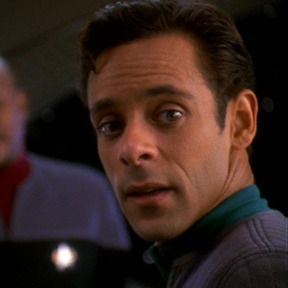
You know, I once spent money on DVD sets. It's sort of annoying that it's all on the internet now. I mean I bought it for the Extras, and joining all the dots it's a good thing I had the DVDs as those VHS tapes really didn't last too long, but still.
Anyway, it's incredibly refreshing to watch a show like DS9 and realise how amazing and thoroughly good television can be. DS9 has a lot of the usual Star Trek faults in its early series, but something happened to it around Series 4. It transformed into a heavily serialised, character-orientated storytelling and cinematic art form. Each episode became a mini-movie; the production values are fantastic, down to the carefully plotted camera shots, the rhetorical flourish of the snappy dialogue, the narrative that built larger and larger arcs and yet was never afraid of a call-back. There's very few shows on today that match the quality of those 1990s types of shows; the sheer dedication long-form narrative is probably unparalleled in today's mainstream television format. It requires and expects a commitment from the audience that producers seem to fear these days. The Walking Dead, Breaking Bad, and other American cable series are reaching for the same thing, but it's almost quintessentially anti-British. I imagine it has a lot to do with budget, but it also seems to be a cultural artefact. British television lends itself well to shorter series, episodic plotting, and set-pieces rather than long-form character development. When we try to go American, we end up with Downton Abbey, and I'm sure I speak for many at this point in time when I say we quite wish we wouldn't.
Then, too, DS9 was politically prescient. Did you know that DS9 invented both the Anti-Terrorism, Crime and Security Act (UK)-cum-Patriot Act (USA) and the rendition of Arab men to black-site prisons? It's true. I'm talking about, of course, the excellent episode 'Inquisition'. 'Inquisition' is one of the best of DS9's episodes, reaching almost unsurpassed heights of tension, character development, narrative twists, and sheer Aristotlean prowess of conflict creation.
It builds on a character who'd been a little lost in previous series. Dr Bashir was hardly a cypher, but he was more archetype than fully-fleshed human being until about Series 5. 'The Wire' explored Bashir's humanity-- his expansive compassion, with all its consequences and its personal costs-- but we essentially hadn't learnt anything new about Bashir since the pilot. He's a good doctor, he's a nice guy, he's a little arrogant in his abilities and intellect, he's both open-minded and naive in that way of liberal bleeding-heart Star Trek heroes, and... that's about it, until the Series 5 revelation that he's genetically enhanced. Suddenly he's not just those things-- he's those things and a fraud. A liar. A man who's hidden a dangerous and explosive secret for thirty years, perhaps so deeply that he himself didn't even think about it most of the time. But the intimation that Bashir had any kind of depths to him created instantaneous layers. Suddenly the slightly contradictory facts of his childhood come into focus. Suddenly the blank slate of his life previous to his post on DS9 is deliberate, not careless, writing. His friendship with Garak, the consummate outsider, becomes a desperate search for personal truth looking into a mirror of a future of a exile, not a foil of Otherness.
And most importantly of all, Bashir's history of questionable decisions must come into new light. He's not just a naif with a youthful zeal for saving life in all its forms, even his enemies. When you wrangle with that amount of genetically enhanced intelligence, you have to anticipate that he weighed the consequences and chose his path knowing more than you did about how it might end. That's where 'Inquisition' is so brilliant. Julian Bashir is not an easy character-- he was hard to love in the beginning, then hard to beat, and suddenly he's hard to accept as part of the Star Trekparadigm. To confront him within the bounds of that very paradigm-- that truth, that justice, that very rigid moral code that demands an odd kind of obedience to a uniform way of life-- Bashir suddenly looks suspicious.
'Inquisition' took everything we knew about Bashir and re-interrogated it. Why is he so dedicated a doctor? Is he really saving lives-- or is he just trying to be better than all of us? Does he express such compassion for aliens and enemies because he views all life as equal, or because he's secretly in sympathy for their Otherness? And for being different, Bashir is interrogated, stripped of his rights, treated like an outsider, vilified by his own command. His Captain, that father figure Sisko, doesn't believe him when he says it's a frame job.
And the show very deliberately puts the audience in the dark. Our sympathy is always with Bashir, but we're allowed to doubt him along with his friends-- to the point where Julian even doubts himself. And suddenly the colourless world of Star Trek has a dark-skinned man being accused by white police of complicity in a war with religious and imperial overtones; he's a spy, he's a liar, he's taking advantage of our open society to bring us down from within. Julian Bashir becomes a literal darkness within Star Trek's pristine lightness. The layers in 'Inquisition' are amazing. Remember, too, that this was written in 1996. An Arab character gets accused of being a sleeper agent and, when the accusation builds to the right pitch of hysteria, the white policeman accusing him uses an executive order of unimaginable reach and power to remove Bashir from his right to counsel and protection to a secret prison to undergo enhanced interrogation techniques. Damn, Star Trek.
But that's not the end. Bashir's innocence is perhaps never truly in doubt. While we wonder and while we view him in a new light and while Bashir himself is pushed, eventually, to admit that he's made decisions that he wouldn't take back but which understandably place him outside the realm of Star Trek's bright moral universe, we know in our hearts he's not an evil man. So the revelation that he's actually innocent is no real shock. What is-- and here's where 'Inquisition' goes from good episode to great episode-- is that the same qualities that cast Julian into shame and doubt are the qualities that make him a perfect spy for real. Julian gets an offer to join Star Trek's equivalent of MI5, or the KGB, or the CIA-- and being the wonderful Julian Bashir that he is, he of course refuses.
And then-- when this goes from being a great episode to a fantastic episode-- his captain orders him to join them anyway. To spy on them from within as a double agent.
It's important to remember that the Original and Next Generation Star Treks would never have risked something so dark, something so grey-edged, and something that implied such serialisation. Picard would have thundered and clashed with his admirals and reamed them all out at episode's end. Sisko admits that Section 31 exists and decides to go after it-- but not on his own terms. He puts his crew in danger to do it. And Julian is a particularly vulnerable character, for all the reasons 'Inquisition' has just explained. There's very little protection for Julian if he does as he's ordered, and his grim, confused expression at the end suggests he knows it. And knows that for all the reasons he's vulnerable, he also has to do as he's told. He's too suspicious if he doesn't provide his commanders reasons to trust him.
Alexander Siddig has gone on to play a range of Arab-ish baddies since he's left Star Trek, in the post-terrorism age. It's interesting to look back at Star Trek and recall that he was cast not as an Arab doctor, nor even as an English one; in the peculiarly American slant that Star Trek always had, Bashir was merely a little exotic, but almost blandly so, a little high-class but not identifiably so, a little foreign, but still totally familiar. And he was cast in foil to Elim Garak, the most obvious 'Outsider' that ever was, so the image of a brown-skinned doctor born to lower-class parents who enhanced their physically and mentally retarded child is all too easily lost against the background of aliens and lost souls. But I think Bashir was one of Sid's best creations: someone fully human, maybe even super-human-- enhanced, yes, but also superlatively sensitive to the demands of humanity because he knew better than most how easy it is to be stripped of that humanity. In the most haunting line of 'Dr Bashir, I Presume?', Bashir says to his father, 'You're not my father. You're my architect.' 'Inquisition' preys on every fear we have about our own foolish youth, our rash actions, our innermost doubts about our identity and our inclusiveness and our ability to be related to by our fellow humans. At the end of the day, we want to be believed in. It's all too easy for that facade to crumble.
[ original source: AO3 ]
#julian bashir#alexander siddig#ds9#deep space nine#star trek ds9#star trek#90s tv#90s tv shows#arab actors#inquisition#section 31
76 notes
·
View notes
Photo


US Federal Judge And New York Cop Linked To Epstein Suicided After Facebook Targets Them For Death
By: Sorcha Faal
A mind-blowing highly classified “Of Special Importance” new Foreign Intelligence Service (SVR) report circulating in the Kremlin today appearing to use information taken directly from a New York Police Department (NYPD)futuristic “Minority Report” computer system keeping track of all of its police officers—known as the Risk Assessment Information Liability System (RAILS) that interfaces with the Crisis Response system controlled by global tech giant Facebook—states that within 24-hours of child sex slaver Jeffrey Epstein being found dead in his high security prison cell, the US Federal Judge overseeing a key Epstein case (US District Court Judge Robert Sweet) was discovered dead in his home—a mysterious death followed yesterday when New York City police officer [NAME REDACTED] was discovered dead with a bullet wound in his head—a suiciding caused by this NYPD officer being believed to have been responsible for posting to the 4chan imageboard website
“Don't ask me how I know, but Epstein died an hour ago from hanging, cardiac arrest…Screencap this” before this death was made public—thus giving reason why, just two days after Epstein’s arrest, Apple co-founder Steve Wozniak sent out a frantic warning to “Get Off Facebook”—a prescient warning made understandable, yesterday, when The New York Times columnist James B. Stewart broke a secrecy agreement to shockingly reveal Epstein had told him a year ago, on 16 August 2018, that he had “potentially damaging information” about “prominent names in technology circles” to include “details about their sexual proclivities and recreational drug use”—and whose revelation of proved, beyond all doubt, that both Stewart and The New York Times are complicit in Epstein’s crimes, as their failure to notify police officials about what he said is in itself a criminal offense of failing to report suspected and/or known criminal activity by a known and convicted child sex predator.
According to the portions of this highly classified report we’re permitted to reveal, in the days since child sex slaver Jeffrey Epstein was mysteriously found dead in his high-security prison cell, the pro-Hillary Clinton-“Deep State”-Democrat Party aligned leftist mainstream propaganda media have launched an all-out “fake news” assault upon Russia—with their primarily spreading repeated lies about a failed nuclear engine test that killed 5 nuclear scientists, and telling further lies about protests in Moscow—the distorted facts of which they’ve mangled to the point that they “can’t decide if Putin is all-powerful or failing miserably”—but whose ordinary and simple truths behind sees Russia having accidentally advanced rocket technology deaths like all countries do (US has had 14 deaths in its advanced technology space programme), as well as its citizens being freely allowed to gather in public places to protest anything they so please (US had millions of protestors turn out in June-2018—still looks like it’s there)—and is why, on 9 August, the United States top international rating agency Fitch upgraded Russia’s credit rating—and who cited Russia’s strengthened policy mix, low external debt and robust fiscal health as their reasons for this upgrade.
The true and honest reason as to why the leftist mainstream propaganda media have launched this “fake news” assault on Russia, this report explains, is because the SVR has been telling the American people the truth about everything involving the mysterious death of Epstein—suspicions about which the US mainstream media continues to downplay—but whose latest stunning revelations include:
The leftist mainstream media telling the American people that shrieking was heard from Jeffrey Epstein's jail cell the morning he died—but was quickly countered by an inmate in the cell next to Epstein, named Nicholas Tartaglione, whose lawyer Bruce Barke told investigators “Nobody heard anything. It was a silent act”.
The leftist mainstream media telling the American people that Epstein’s prison was a mass of incompetence so bad its warden was removed and the guards watching Epstein were placed on leave—but was quickly countered by Dana Gottesfeld, whose husband was imprisoned in the same unit Epstein was, who described this prison’s security as being “really intense” and stated: “So they’re very, very keen on security. They pay very special attention to high profile cases, so it’s hard to imagine that Epstein would not be given at least a three guard escort”.
The leftist mainstream media telling the American people that Epstein’s computers were seized by the FBI when they raided his “Orgy Island” compound in the Caribbean on 12 August—a more than provable lie as drone video footage shot on 15 July showed one of Epstein’s computers clearly visible in his kitchen—while a second drone video taken on 23 July shows this computer missing, along with everything else that had been in this kitchen.
One of the gravest dangers facing those complicit in child sex slaver Jeffrey Epstein’s vile crimes, as well as those covering up his death, this report concludes, is US Federal Senior Judge Lewis Kaplan of the United States District Court for the Southern District of New York, who oversees all US federal criminal and civil cases originating from the US Department of Justice prosecutors belonging to the Southern District of New York, and who, also, are handling the case against Epstein and his conspirators—but who, yesterday, erupted against these US federal prosecutors and became the first US Federal judge in known history to file his own criminal charges against a defendant when they refused to—thus leaving no one knowing who he’s going to strike out against next.
0 notes
Text
10 Representative Jdramas of the 2010s (so far)
This post is inspired by, or rather, is a reply to this excellent question posted by an anon to @jdramaconfessions. I meant to reblog the post with a reply but then this post got MASSIVE so I decided to just make a new one.
Of course, the best answer to that question of what are the representative dramas of this current decade can only be written in about 2025, when there is enough time to look back and take stock of what dramas actually stood the test of time. As it is, there are still 3.5 years left to the decade – and if 2013 and 2016 was any indication, one fairly good year could give us a couple of hits. That being said, I’m going to try.

I think the best place to start, when trying to curate a list of representative dramas is first to ask – how exactly does one define representative and what are these dramas supposed to be representative of?
The word ‘representative’ is tricky to me because it implies something different than ‘favourite’. When asked for a list of ‘favourite’ dramas, it’s definitely personal, and there’s no need to try to choose something objectively. But the word ‘representative’ implies that there has to be some sense of objectivity to one’s choice, even though I agree with the admin of jdramaconfessions that at the end of the day, personal preference still comes into play.
I define representative in three ways.
Firstly, by memorability. We are still living this decade out, so it’s hard to say which dramas will stand the test of time in the next decade or so. Still, I’m sure that there are a number of dramas from the early 2010s that cling on to our minds and are still referred to often.
Secondly, by popularity. I don’t mean to say that every popular show that has come out in the past decade is automatically memorable or representative drama. In fact, quite the contrary. Every season will inevitably have its own popular drama. But there are a number of dramas that have exploded in popularity and I feel that it is then valid to give them a spot on the list. After all, to an extent, popularity indicates a show’s ability to resonate with a wide audience. I will also try to choose dramas that are popular both domestically and internationally. Making popularity a criteria is also why I sadly exclude excellent dramas like the Oguri-led BORDER and gothic drama Karamazov no Kyodai – both were insanely memorable and unique to me, but perhaps not commercially popular enough to make them ‘representative’.
Thirdly, by innovation. This is also a way to address the question of ‘What exactly are these choices supposed to be representative of’? Jdrama is a big umbrella of many sub-genres. A representative drama of one sub-genre (say romance) may not always be representative of the entire group. Though to be sure, there are times when they overlap. So what I mean by ‘innovation’ is any given drama’s ability to give fresh life to their genres, and bring something new to the table. It’s a drama’s ability to be either be excellent within the constraints of its genre, or conversely, its ability to push the boundaries of the genre.
With that being said, I’ve got chosen a couple of dramas I think fit the bill – In no particular order after the cut!
1) Hanzawa Naoki
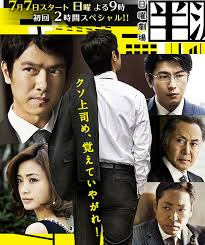
I’m putting this one first because @midnightrain910 brought it up. Yes. Personally I didn’t think Hanzawa Naoki was THAT great, but boy was it adored by repressed salarymen all over Japan. I literally had 2 of my (Japanese) managers come up to me to ask me if I’d watched it – on separate occasions! I mean shame on any 2013 Japan enthusiast who didn’t know the “bai-gaeshi” catchphrase. It also cemented Masato Sakai’s reputation as a credible and commercially viable actor.
2) JIN 2
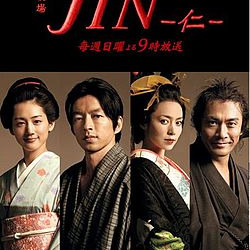
I thought JIN 2 was inferior to the first season, but I included it anyway because I wanted to somehow squeeze JIN into this list. JIN is the historical, time-travel, medical drama OF DREAMS. It was so well-acted and so unexpectedly good. Just last year my Turkish colleague was raving about it to me. In that sense, I think it is an internationally accessible jidaigeki with a lot of heart.
3) Strawberry Night
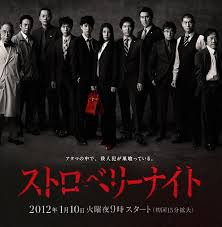
Ok so, if you were to compare Strawberry Night with the MANY other Japanese crime/detective dramas, you wouldn’t find it definitive or groundbreaking. But still, it was GOOD. Sure I may be biased, but look, it lasted 2 SPs, 1 full season and 1 movie. If that’s not a testament of its popularity I don’t know what is. It managed to weave a bit of romance into it too. Also I think this is the series that threw Nishijima Hidetoshi into the limelight. He’s been around for ages, but I don’t think he had done anything since Asunaro Hakusho that was really popular until Strawberry Night.
4) Juhan Shuttai!
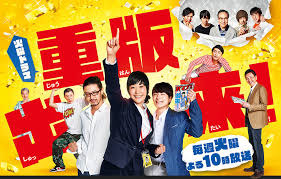
Juhan Shuttai! never set out to be critically acclaimed or sold itself like it was a precious gem filled with top actors. Nah, it set out to be a feel-good show but boy was it that and MORE. It just goes to show that great characterisation and a solid plot will bring a show far. That’s not to say that the actors weren’t good. A few of them were excellent, some of them were serviceable. I just wanted to point out that unlike some shows (cough Triangle, cough Rich Man Poor Woman, cough MOZU), they didn’t overpromise and underdeliver. Also, oftentimes well-written dramas happen to be so serious. I would really love to see more in the vein of Juhan Shuttai! (And Legal High, if I might add).
5) Quartet (2017) - Not to be confused with the other jdrama of the same name
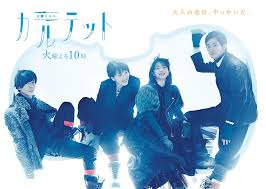
Putting this in despite not having watched it because all the reviewers that I trust to give an honest opinion found that it lived up to its hype. THANK GOOD HEAVENS. After giving the couple of examples above of how a good cast doth not a good drama make, I’m glad that Quartet can now live on as the drama which BROUGHT IT. Also I wasn’t about to make this list without Mitsushima Hikari (If Quartet hadn’t made it I would have put in Woman). She’s one of most excellent actresses to have surfaced this decade. It’s so odd because I remember her from Folder5 days – and who would’ve known she’d be here today.
6) Marks no Yama
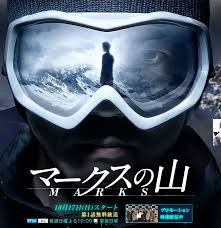
To me this must have been the drama that put WOWOW on the map. It was that drama that made everyone sit up and realise that WOWOW wasn’t just a second-rate channel airing foreign shows. It had a good strategy going – a very strong understanding of its niche, and the willingness to ignore popular models and idols and go for gritty, well-written fare instead. Because I’m ultimately quite a frivolous drama fan, I must have to say most of WOWOW posters (and shows) don’t really attract me, but the couple that I have watched have wow-ed me (pardon the pun).
7) Itazura na Kiss ~ Love in Tokyo
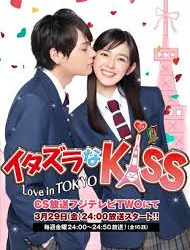
Ok it was a toss up between Good Morning Call and this one, neither of which I watched by the way. Well I did attempt one episode of GMC but I just….couldn’t. The truth is, now that I teach Japanese high-schoolers, it’s very hard for me to watch dramas with them in it. Though in a sense I’ve outgrown the genre, it’s more of a ‘this hits too close to home’ thing. That being said, high school dramas are a staple of drama world and it’d be weird not to include at least one. So I just went with which one I heard about the most.
Admittedly, the early to mid 2000s were a heyday for high school dramas to me. I’m hard-pressed to find a Stand Up! or Nobuta wo Produce among the current lot of dramas. They just don’t make them like they did anymore. That’s not to say it has been bad. I thoroughly enjoyed Narimiya Hiroki and Niigaki Risa trying their darndest to act like teens in Yankee Kun to Megane Chan. I was impressed that Piece managed to build itself into a dark mystery cum social commentary despite having pretty weak actors. I heard Sprout was cute. THAT SAID, none of them could be considered representative in my book.
As such, Itazura na Kiss stands out for being one rare remake that actually became as popular as its predecessor – and which was one teen drama to capture the hearts of international tumblrites.
8) Saikou no Rikon
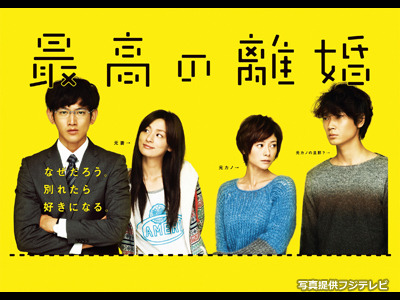
Not only was this the show that introduced me to the genius that is Ono Machiko, it was the drama that turned the romance drama genre on its head. Its dialogue was witty, it was unapologetically real. And I think it made more writers sit up and realise that it’s the 2010s and they should really be challenging romcom stereotypes, not mindlessly rehashing them again and again.
9) We Got Married as a Job
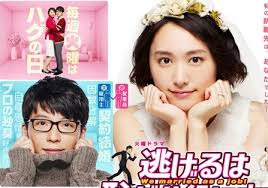
@repinipi brought this up and yes, HOLY SMOKES this was THE romcom of 2016. It took Japan by storm. Till now theme song Koi is still on the top 10 of karaoke charts. My kids went wild when we teachers danced it at grad party. People still talk about the drama and Hoshino Gen is capitalising on it. Solidly written, it managed to be realistic, though the circumstances were obviously way to fictional to happen in real life. In 2020, I think this drama will still be looked upon fondly.
10) HiGH & LOW
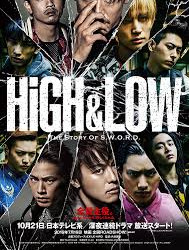
I thought about this. I thought about this long and hard because, should H&L even be considered on the same plane as other dramas? At its core, it’s more of a promotional vehicle. But it just threw the delinquent/gang genre and shook it up into it’s own visually brilliant spectacle. It will probably never find its place among mainstream audiences in Japan. But it has grown its own dedicated fan base. If anything I’d compare it to Tokusatsu and Takarazuka fandoms. They are niche, but there are there, they are proud, and they are ready to throw some bills. LDH took J&A’s ambition and promotional ideas, then stepped it up a couple of notches. If anything, the business savvy of this company puts the entire series on this list.
Final Thoughts
I am just one person who simply hasn’t had much time to watch as much jdrama as I’d like. So its inevitable that I would have missed some out. Also, to make the arbitrary number of 10, I was unable to put some other picks on (trust me I would put either SPEC, Yae no Sakura, or Sanada Maru in in a heartbeat). Well, it wouldn’t be representative if too many made the list eh? Lastly, please remember, objective as I try to be, feel free to agree or disagree. Let me know your picks! :)
#jdrama#jdramas#hanzawa naoki#saikou no rikon#juhan shuttai#quartet#we got married as a job#Nigeru wa Haji da ga Yaku ni Tatsu#high&low#jin#marks no yama#strawberry night#itazura na kiss love in tokyo
62 notes
·
View notes
Photo
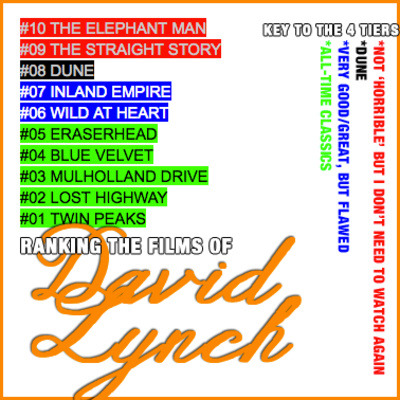
I am going to post this text which I used to make this 90-minute podcast where I ranked all of David Lynch's films. It’s close to 5,000 words long. Since I took the time to write all this out, I wanted to post it, edited for the page. Enjoy:
David Lynch has created ten feature films in forty years, specifically between 1977 and 2017. I am going to rank all ten films right now.
I’ve broken down the Lynch filmography into four tiers.
Tier #4 consists of two films that, while they’re not necessarily horrible, I’d be OK with never re-watching again.
Tier #3 is Dune, just… Dune… (crickets)
Tier #2 also consists of two movies, two features that are close to being really great, but are ultimately flawed for very different reasons.
And then there’s the Final Tier, Tear #1, ALL-TIME CLASSICS, of which, by my count, there are five. Not bad, considering that equals, oh I don't know... half of his filmography.
You might be wondering what constitutes an ALL-TIME CLASSIC... great question. In my book, it’s a movie that scores a 9.500 or higher on my highly scientific to-the-thousandths scale movie review scoring system. All ten of these feature films have been scored between 5.999 and 9.819. Using the thousandths scale allows for accessible gaps as I slowly fill in the list as I continue to compile my personal ranking of the greatest films ever made (and also... the not so great). I urge you to go to my website www.movies.myameri.ca to see the list of over 200 films that I've reviewed and ranked thus far.
Now, let’s get to the list...
#10
Perhaps, The Elephant Man––David Lynch’s second film, from 1980––doesn’t work for me because you can feel, in a sense, that he’s selling his soul. Sure, it's "good" and was recognized as such in all the ways and by all the metrics that the most mainstream critical pipelines assess and award art that is "good."
It's what I couldn't put my finger on at the time I recorded my initial review, and the truly repulsive thing about it: It's bad in the way these "good" films often are. It feels older than it is: a 1980 film about the 1920s that feels like it was made in the late 50s. It’s stylistic feel is both confusing and confused. The brief intrusions of Lynchian originality are present and welcome, but they’re all too quickly dispersed by stale set pieces, and performances that are either overwrought or stiffly boring. Only Freddie Jones, in the devious role of the elephant man’s original "handler," strikes a cord.
The look and feel of John Hurt’s titular character is effective, because it is grotesque. It is in no way fantastical, even if we’re looking at the height of movie magic, because this person existed. And through this realism, a sickening is induced. With every one of Hurt’s nasally slurps––while that’s surely the point, and it wholly succeeds on that level––the film becomes less re-watchable, a major tenant of my grading scale. Wherein Eraserhead’s baby is pure fantasy––a goofy, disgusting, horrifying little buddy that the viewer wants to spend time with––the Elephant Man is an abomination. Our horror with him, at him, over him, is both the movie proving its thesis, and shutting itself down.
David Lynch is on record as having been pleased with the film, but what amount of that pleasure has been framed by four decades of opportunity in large part because of its success, isn’t clear.
The Elephant Man was nominated for eight Academy Awards. No other David Lynch feature was nominated for more than one. It is his worst film by a wide margin.
#9
It would be easy to dismiss 1999’s The Straight Story as a joke disguised. Here was David Lynch making a relatively, well, "straight" movie about a man named Alvin Straight and it was titled The Straight Story. It was released by Disney. When I rewatched this recently I imagined what the movie might have been like if it had the same plot but, you know, felt Lynchian. What it would be like if the entire film had the tone of my favorite scene, the "I LOVE DEER" scene... but, alas, it isn't that.
The film is just a feel-good story. Sometimes, when you peel back the layers, there's just more goodness hiding underneath, and nothing more. And maybe there's a kind of horror in that as well.
#8
Dune stands alone.
Released in 1984, it's the only film among the ten wherein Lynch didn't have complete final cut. It's, by any classic metric, a bad film. At the end of the documentary Jodorowsky's Dune, which details one of the first attempts at bringing the best selling science fiction book of all-time to the big screen, Alejandro Jodorowsky describes going to see Lynch's version and being filled with a perverse glee that the movie was a failure, that it sucked. And it is definitely a failure.
The film is a god-awful mess. Do not under any circumstances attempt to watch the 3-hour "extended cut" version. Lynch had nothing to do with this and it does not re-insert anything by way of noteworthy lost footage. It merely accentuates the worst elements of the original theatrical cut. The biggest crime by far being... the dreaded voice-over, which plagues both versions.
In 2011, a YouTuber posted a 9-minute super-cut compiling all of these whispered voice-overs, which––if you aren't familiar––are meant to give more clarity to the story by presenting the audience an inside look at "the thoughts" in various characters' heads. But these "thoughts" do exactly the opposite: bogging down the story and actually making it harder to follow (in my opinion).
But even with all of its many, many flaws, the film is not without its charm. The look of it is extremely interesting, if not inconsistent. Some imagery looks dated, while other effects seem ahead of their time. The soundtrack, an amalgamation of Toto's overblown rock aesthetics and a nuanced main theme co-written by Brian Eno, is kind of awesome
But really Dune is just a huge mess of ideas. For example, in one scene the actor Freddie Jones is given a cat with a rat taped to its side, hooked to a contraption, and is told to "milk the cat" if he wants to stay alive. His character is never seen or mentioned again. These are the ideas of Frank Herbert told through the lens of David Lynch and filtered by producers who were so damn concerned whether or not the plot would make sense that they butchered the whole damn thing. What's left are pieces, intriguing pieces strewn about the 2-plus hours.
It would be easy to submit this film as the last place entry, #10 out of 10. But I just can't do that. I would re-watch this under the right circumstances. The strange convergence of wild visuals, bad editing and too-fast, too-big, too-soon nature of the production, puts this in a special category among the Lynch filmography. It almost hits "so bad it's good" notes, in a way. When Denis Villeneuve unleashes his high stakes, huge expectations version of Dune in 2020, David Lynch's third film will likely become nothing more than a footnote.... a grain of sand among the great DUNES of film history, one might say. (Sorry.)
#7
Inland Empire is, technically speaking, the final film of David Lynch's career. Released almost thirteen years ago in 2006, it's certainly the most confounding. Three hours of lo-fi footage, welded together by a director whose contempt for the industry he was a part of had reached a boiling point. And that boiling point is INLAND EMPIRE.
For years, I attempted to watch this film in stops and starts. That, for quite a long time, I never got past the relatively straight, narrative-driven first hour is probably telling. Outside of a classic Grace Zabriskie appearance as Laura Dern's crazy Polish neighbor, not much really happens.
But it isn't so much that nothing is happening that's the issue. It's that nothing interesting is happening. An actress gets a role. Her co-star is a womanizer. Her husband might be jealous. There's some mystery concerning the development of the project. They have an affair. After a burst of imagery at the start, this all unfolds in a fairly normal fashion. The most noteworthy thing about it is how it looks. Lynch used a digital camera to film some ideas with Laura Dern one day and then decided to make a feature film out of it. He's stated that he had to keep using the same camera out of necessity. That he had to make it look this way, is a very Lynchian answer to the question "Why does INLAND EMPIRE look like garbage?" Because it does truly look like trash. You can get better video fidelity from any cheap Android phone nowadays. It has not aged well.
Some might point to this and say that's exactly why it's genius, why it's underrated... but I ain't buying that line of thinking, either. It's a misstep, in my opinion. The film is a bloated experimentation of a script written on the fly. It has only one true saving grace... Laura Dern.
Even if they hadn't reunited for the successful collaboration that was Twin Peaks: The Return, I think I'd be OK with this being the pair's final work together. The film only works because of Dern. The entire thing is a testament to her ability and it transcends the hardware that was used to capture it. When I finally got around to completing this watch, I was struck by how weird it got. Which is saying something about a David Lynch film! Without Dern this might play like someone's forgotten student project of the mid 2000s. With her, it's a strange bookend to an amazing career.
One that I have no other choice but to start, and stop, and start again. Someday.
#6
Wild at Heart was produced at the height of David Lynch's success in 1990. Riding the high of Blue Velvet, arguably his most beloved work in a critical sense, even to this day, and filmed just as the world was experiencing TV’s Twin Peaks. Lynch's fifth movie arrived just as the concept of "Lynchian" was soaking into the cultural landscape. It's a brash, outrageous film that feels like the work of an individual who could no wrong. This cockiness both makes it fun, and provides its flaws.
While there seems to be "a point," however cloudy and/or veiled and/or vague, behind most things in every David Lynch film, Wild at Heart seemingly indulges in bombast for the sake of bombast. It's no surprise this Louis CK's favorite film and the film that nearly gave Roger Ebert a heart attack. (See this video)
I'd like to split the difference between those two sentiments, if I may. I don't agree that Lynch is always trying to "get off the hook" as Roger Ebert put it. But that may be the case with Wild at Heart. That it is the only Lynch film to take the top prize at Cannes, perhaps speaks more to the idea of Lynch and his influence in the culture at the time, then it does to the film itself. CK was right to read this film as a comedy, it's the only way it works. And Ebert was wrong to crucify it for being such. But It stands outside the top tier of Lynch's career for a different reason. With cockiness comes laziness. Lynch notoriously had his hands full during the development of this project, as he abandoned the TV world of Twin Peaks to make it. Wild at Heart feels half-baked as a result.
Sure, it has its moments. Willem DaFoe gets to hang his hat on the mantle of notable, completely over-the-top supporting characters in the Dennis Hopper / Frank Booth tradition. And Nicolas Cage and Diane Ladd are every bit as crazed in their performances as well. And yet, therein lies another problem: the movie has only one speed, out of control. The Sailor-Lula love story is meant to provide the downbeat, something earnest in a sea of chaos. But it falls short. You can't stop to smell the roses if the car never stops.
#5
That half of David Lynch's filmography constitute all time classics is no minor accomplishment. I imagine there are only a handful of directors with a better batting average. And so, the order of these next five films is fairly insignificant. Certainly there are biases at play which have placed them into the positions you find them here. For example, I certainly haven't watched Eraserhead enough and I've probably seen Mulholland Drive too many times by comparison. It's also about timing. Maybe This Moment™ in My Life™ is more fitting for Lost Highway then it is Blue Velvet, for myriad reasons, and so on and so on.
The thing to know is this... These five projects have all stood the test of time, and any one of them is deserved of the top spot. Now, back to the countdown...
Eraserhead was exactly like I thought it would be.
I neglected to watch this film for a very long time. I kept telling myself "Now is the right time to watch Eraserhead, Jeff." What I didn't realize until I finally watched it is that the answer to that question is both never and always.
Eraserhead is a feat of nature. A film that took years to complete feels and flows like it was molded together over a single month. It almost feels silly to expound on the film at this point. It's been dissected to death. Even critics who fail to understand it can appreciate it on the most basic of levels. This. Is. Art. PERIOD. There's no denying that.
Wherein the surrealists who decided to make films couldn't get past the concept of the singular idea, confining their work to shorts OR a series of loosely connected "living paintings," Lynch was able to extrapolate the aesthetic to feature length and also tell a story.
It's soundscape alone is a work of art, and perhaps the most important facet of the film from a historic point of view. This world sounds exactly as it looks: manufactured, fractured, jarring and glum. What brief respite the Lady in the Radiator provides with her haunting, off-kilter serenade is all we get by way of counterpoint to the unnerving soundtrack of Lynch's debut feature. It took Lynch, working in tandem with master sound engineer Alan Splet, nearly a year to complete. From the 1991 book, Midnight Movies:
"The soundtrack is densely layered, including as many as fifteen different sounds played simultaneously using multiple reels. Sounds were created in a variety of ways—for a scene in which a bed slowly dissolves into a pool of liquid, Lynch and Splet inserted a microphone inside a plastic bottle, floated it in a bathtub, and recorded the sound of air blown through the bottle. After being recorded, sounds were further augmented by alterations to their pitch, reverb and frequency."
Lynch's first film is also his shortest, just shy of ninety minutes, and it's hard to find any flaws. Is the detour with the severed head at the pencil factory meaningless? How about the next-door neighbor character... unnecessary? Inside the Top 5, I won't be nitpicking just to do so. In the Top 5, everything is fine.
#4
While I don't necessarily think Blue Velvet is the best film of David Lynch's career, it's hard to argue that it isn't the most important. It is the world from which all subsequent Lynch things are built. Following the creative and commercial disaster of Dune, Lynch's fourth feature is a dark psychological horror that both expands upon and completely blows apart the aesthetic of Film Noir. And there really isn't a single David Lynch film project after Blue Velvet which doesn't also explore this form to a degree.
The movie marks the debut of a pair who would turn out to be lifelong collaborators in the David Lynch cinematic universe: Laura Dern, acting here in one of her first "adult" roles at age 19, and the composer Angelo Badalamenti. Badalamenti would go onto write the scores for every subsequent entry in the filmography except Inland Empire, and his main theme to Blue Velvet remains one of the most memorable.
Blue Velvet is also notable as being a vehicle for Dennis Hopper's re-entry into mainstream cinema. Relaunching his career, Hopper's portrayal of the deranged Frank Booth remains as skin crawling as ever.
I think the fact that I have watched Blue Velvet and Mulholland Drive more than any other of Lynch's films had a lot to do with where I've placed them on this list (that they aren’t higher). But I swear I'm not being contrarian for contrarian's sake. As I said a minute ago, all five of these films are worthy. When it comes to the movies of David Lynch, well, I guess you could say, "....HE PUT HIS DISEASE IN ME." (Sorry.)
#3
The strange origin story of Mulholland Drive somehow eluded me for years. I only found out that this movie, Lynch's ninth, released one month after 9/11, was literally developed and shot with the intention to be a TV pilot for ABC. I found this out from the book, Room to Dream, by the way. The half autobiography/half biography of Lynch's life, which came out last year that I highly recommend. Only when it was clear that it wouldn't work for television did Lynch decide to re-cut and film additional footage to release as a feature. Though this was common knowledge, I managed to watch this many times over the years with no idea. When I rewatched it again recently with this information, I couldn't help but try to pick out what was filmed when in the timeline, and if I could see any inconsistencies... a true hellish way to watch a picture. I don't recommend it. But I digress..
From Blue Velvet on, each one of David Lynch's films (outside of The Straight Story) has had a longer running time. At close to 2½ hours, 2001's Mulholland Drive was his longest to date by a decent margin. It’s something of a misnomer that Lynch's films meander, as people mistake deliberateness for slowness or frivolity. Mulholland is filled with detours, inhabiting the film like micro movies in their own right. This also continues the loose Los Angeles trilogy (after Lost Highway and concluding with Inland Empire), which, at their heart, are films about coming to grips with who you really are. This might be the most direct lampooning of the film industry itself, but all three deal with being someone who you're really not.
Lynch has repeatedly stated his admiration for the 1950 film noir classic Sunset Blvd., another film about the film industry. In some respects, the naïveté of Naomi Watts' Betty is the counterpoint to Norma Desmond. In Mulholland Drive, her character says, "I'd rather be known as a great actress than a movie star. But, you know, sometimes people end up being both." Whereas, Norma Desmond portrayed by Gloria Swanson, has already reckoned with the true fate: "No one ever leaves a star. That's what makes one a star."
The arc of the characters—plural—Betty and Diane, and the power of Naomi Watts' performance as them both, is behind the wheel on Mulholland Drive. I found it odd that she took second billing in the opening credit crawl to co-star Justin Theroux. Was this because she was unknown to the masses at the time, or perhaps another piece of the puzzle to this movie's greater themes?
Mulholland Drive touches all the bases. At times bleak and bizarre. Sometimes bright and hopeful. In many ways, it's modeled after the next film on our countdown, as it can almost be read as two separate entities: converging, crossing and meeting together again? Well...
#2
No film surprised me more during my recent rewatch binge then 1997’s Lost Highway. David Lynch’s seventh film might be his most divisive, in so much as it failed to ignite the critical response that really any of his other films did upon their release.
While it’s industrial rock heavy soundtrack perhaps dates the film to its actual era of production more than any other Lynch picture, it also works as an anchor. Outside of Inland Empire, this is easily his most abstract and seemingly rambling work. It is grounded through style and feel. And it might just be his best singular statement.
Bull Pullman is a revelation as the jazz saxophonist Fred Madison. His chaotic emoting on the stage through his blaring instrument is but another counterpoint, this time to his subdued, confused off-stage demeanor. Who knew the goofy President from Independence Day could pull this off?
My critique of Patricia Arquette in many of her other roles is that she comes across as lifeless. Well, with her performance here as a dead-on-the-inside beauty, that mode has never played better. She's tremendous, acting the conduit in this strange play, this circuitous journey that is often described as a theatrical möbius strip, where our leading man has quite literally been replaced.
And that brings up another interesting point: There doesn't seem to be a traditional main character in this film. Arquette in her dual role as Renee and Alice is functionally it, but she gives way to Pullman and Balthazar Getty's Pullman––a car mechanic named Pete––for long stretches, and its Lynch's most diplomatic film in terms of dolling out the heavy lifting in this regard.
And last but not least we have to talk about... Robert Blake.
In a sea of outstanding, intensely weird and occasionally unforgettable supporting characters throughout the Lynch filmography, Blake’s Mystery Man might just take the cake. That Robert Blake, more than likely an actual sociopath, instructed Lynch on his character’s look––which, let me remind you was such: Blake decided to cut his hair cut extremely short, parted in the middle, white Kabuki make-up on his face, and an all black outfit––might be the best example of the auteur trusting his instincts, and having it pay off completely. Only on screen for a handful of scenes, Blake, who would be arrested and acquitted for the murder of his wife just a couple years later, delivers a truly unsettling performance. In his final film role ever, he encompasses true evil more than Twin Peaks’ BOB or Frank Booth in Blue Velvet. The Mystery Man is the lurking, vile corruption of what’s good that Lynch has always been looking for.
But Lost Highway is not a “what’s beneath the surface” film like Blue Velvet or Twin Peaks or even Mulholland Drive are. The “point” of Lost Highway might just be that evil exists in plain view... and there’s nothing we can do about it. Gary Busey sometimes has to watch his only child disappear in a lightning bolt of spoiled meat and that’s that. When they reappear, broken and struggling, and falling down the same path until it happens again, well... that’s just life.
One of my favorite parts of the entire movie is a scene early on when a detective asks Fred Madison if he owns a videocamera. His wife, Renee Madison, portrayed by Patricia Arquette, responds, "no, Fred hates them." Fred responds, "I like to remember things my own way." The detective asks, "what do you mean by that?" Bill Pullman, as Fred Madison, replies, "how I remember them. Not exactly the way that they happened."
#1
(DISCLAIMER: I’m sorry if you think it’s cheating that I am including the expanded Twin Peaks Universe as one single entry on this list. I’m sorry if you think the only thing that should count is Twin Peaks: Fire Walk with Me because that is the only Twin Peaks thing that is actually a “feature film.” But also: SORRY NOT SORRY.
This is my list and I’m putting Twin Peaks at #1, specifically: all of Season 1 of the original TV show, plus the beginning of Season 2 (until the episode where we find out who killed Laura Palmer) and the Season 2 finale. Then of course Fire Walk with Me, and the 18 hour MOVIE that is Twin Peaks: The Return, or Twin Peaks Season 3, if you will (I prefer the former as it gives the masterpiece the gravitas it deserves).
If you put a gun to my head and I ABSOLUTELY had to only include Fire Walk with Me, I would probably drop it to #4 or #5 and slide everything else on the list up a spot. End of DISCLAIMER.)
I was given the Twin Peaks Gold Box as a Christmas gift in 2007. The 10-DVD set had just come out and this was still an era when people treasured physical things like that. It was really important and meaningful to me, and I still own it despite no longer having a DVD player. Watching it for the first time was a treasure and a fond memory. The feeling I got when I heard that Badalamenti theme music start the show and everything in between...
...yes, even James in Season 2. I loved it all: the good, the bad and the ugly, the whole kitten caboodle. The original TV series is, obviously, far from flawless. Lynch stepped away for long stretches before going fully AWOL after it was revealed that Laura Palmer's father, portrayed by the great Ray Wise, is in fact her killer. After that, the show took a turn (to put it lightly).
But Lynch never gave up on the world. He returned to helm the stunning Season 2/de facto series finale. So much of the mythology that Fire Walk with Me and certainly The Return is built upon is ignited in that finale, fittingly titled "Beyond Life and Death." But really, the original series is most notable for merely existing at all. A precursor to the "golden age of television" that was right around the corner, there still hasn't been a network series remotely this daring. There's often much made, too much if you ask me, about the "cult of David Lynch." Critics of this “cult” say its followers are blind: The man can do no wrong. It's weird for weirdness' sake. And so on, they drone. Now, I'm a fairly big David Lynch fan (no duh). But I've always tried to remain grounded in regards to this. He's not perfect. But he has made near-perfect art. And I'm a fan of ART first. A practicer of admiration? Maybe some distant second, third, fourth or beyond. I see his infiltration of the masses with Twin Peaks as one of his finest achievements in the arts. How many powerful people had to be convinced that the mainstream was ready for something like this. It's baffling. That, of course, they weren't ready is kind of besides the point. Someone has to poke the bear.
If Lynch had closed the books on Twin Peaks with Fire Walk with Me, his sixth film released in 1992, that would have been fine. It's a polarizing feature and was a fairly significant box office bomb, even for Lynch. Fire Walk with Me nonetheless retains an otherworldliness among the filmography. Given the subject matter––you know, just your average super-violent father-daughter incest rape thing––it's hard to argue this isn't his darkest tale by a wide degree. It's perhaps not ripe for repeated viewings. In fact, I did not rewatch it for this review, the only film of the ten. Why? Well, I had given it a replay back in 2017, just before the debut of Showtime's Twin Peaks: The Return. And, to be honest, I just wasn't ready to return to this madness quite so soon.
Only David Lynch could mold one of the loftier aspects/thematic devices/main characters (?) of the long-awaited follow-up to perhaps his most beloved work on one of the most random, seemingly meaningless, toss-away lines spoken in a bad Cajun accent in a cameo role by David Bowie. "We're not going to talk about Judy at all..." Until, that is, the time is right... Say... 25 years later?
I just recently began to rewatch The Return and I'd like to say thank you for this, David Lynch. This needs to be put into the discussion with his greatest work, if it's not already there. I can recall after various episodes of its original run (May to September 2017), feeling a sense of awe and wonderment and confusion and joy. I say to anyone that's curious that this is an 18-hour movie. David Lynch made an 18-hour movie when it wasn't certain if he'd make any more movies again.
It would be dumb, if not downright foolish, to try and hash out the plot-lines or gush over Kyle MacLachlan's performance in not two, but three distinct roles. Here, the duality of man has fractured yet again in these modern times. And when I got to that final two-hour finale, I found myself on a family vacation. So I carved out a block of time to watch it at the house we were renting on my laptop, alone, in the dark, as the rest of my family enjoyed a sunny day at the beach. I filed Kyle and Laura Dern's Diane into one more sketchy motel and then onto El Paso, Texas, of course, just as everyone had guessed, and then back to Twin Peaks, Washington, where the series ends on a question... Special Agent Dale Cooper turns to Laura Palmer outside her childhood home and asks, "what year is this?" She screams into the abyss and the lights in the home spark off and the screen explodes into darkness. For a series that was, ultimately, about the passing of time as much as it was about the origins of evil in the universe or anything else, it was a fitting end.
0 notes
Text
WHAT TO WATCH THIS WEEKEND January 25, 2019 - The Kid Who Would Be King, Serenity
(Yes, I realize the weekend just ended for most, but hey, might as well get an early crack at NEXT weekend, huh? January is winding down with what’s going to be seem like a fairly boring weekend after last week’s M. Night Shyamalan sequel disappointing when compared to the sensation of Dragon Ball Super: Brolly, a movie that few movie writers knew about before Wednesday but grossed $21 million in six days. But hey, variety is the spice of life, and the two movies opening wide this week certainly add some spice with a duo of films from reputable British writer/directors.
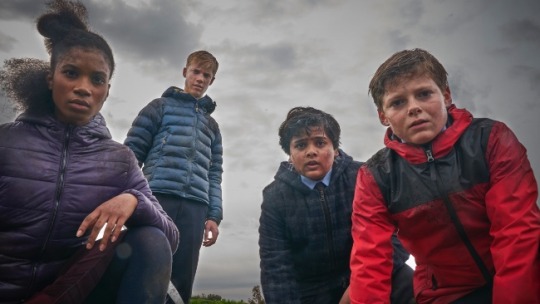
THE KID WHO WOULD BE KING (20thCentury Fox)
Written and directed by Joe Cornish (Attack the Block) Cast: Louis Ashbourne Serkis, Dean Chaumoo, Angus Imrie, Tom Taylor, Rebecca Ferguson, Patrick Stewart, Rhianna Doris, Denise Gough MPAA Rating: PG
On the one hand, this action-adventure film is an exciting one, because it’s the second feature from Joe Cornish following his astonishing 2011 debut Attack the Block, but also, because it’s Cornish’s first studio feature for a mainstream audience, geared towards family audiences in particular.
It’s a fairly standard take on the King Arthur mythos with a young British lad (played by Andy Serkis’ son) finding Excalibur, the legendary sword in the stone and having to team with his best friend (and a couple school bullies) to take on the return of Morgana le Fey (Rebecca Ferguson).
It seems like a good idea to get kids, especially young boys, interested in the tales of King Arthur even though the last few movies have bombed as neither Guy Ritchie’s 2017 film King Arthur: Legend of the Sword or the Jerry Bruckheimer-produced 2004 movie King Arthur found much of an audience. In fact, trying to bring any British legend to the screen and get American moviegoers interested might be a fool’s errand, as seen by last year’s Robin Hood bomb.
The thing is that other than Patrick Stewart – star of Fox’s ongoing X-Men franchise, which seems to be in limbo these days -- and Rebecca Ferguson from the last couple Mission: Impossible movies, there are no stars in the movie that could entice those on the fence about whether to see this movie. On the other hand, reviews have generally been good which could help boost interest a little more going into the weekend.
At first, I thought maybe this would end up with around $10 million, but it’s basically going to be a family movie coming into a market where most other family films have been in theaters for three weeks or more. (Dragon Ball is an exception.) Fox was also able to get it into more than 3,4000 nationwide, because wisely, it waited until after Glass opened for this. Because of this, I’m going to goose up my number to somewhere between $11 and 13 million with most of the family movies geared towards boys falling away and Joe Cornish’s older fans maybe giving this a look. Sadly, the movie is not being marketed as “from the director of Attack the Block” as it clearly should be.

Mini-Review: Granted that Attack the Block was always going to be a hard act to follow for Joe Cornish, and yet he has written and directed a follow-up that might appeal to younger moviegoers though maybe not so much Cornish’s older teen fans from his directorial debut.
Louis Ashbourne Serkis, who is indeed the son of Andy Serkis, plays Alex Elliot, a fairly normal 10-year-old, who stands up to a couple school bullies and while being chased by them finds a sword embedded in rock on a construction site. It is indeed the fabled “Sword in the Stone” Excalibur as used by King Arthur. Along with his best friend Bedders (Dean Chaumoo) and their two relentless bullies (Tom Taylor, Rhianna Doris), they all go on a quest to fight Arthur’s evil sister Morgana (Rebecca Ferguson) and save Britain.
The first major hurdle this otherwise fine kids’ action-adventure faces is the fairly weak cast, because without liking Alex or his colleagues, it’s hard to root for them even with the stakes never feeling too great. The one exception is Angus Imrie as the young Merlin who somehow manages to get more laughs than the older Merlin, played by Sir Patrick Stewart. Alex’s mother is played by Claire Foy lookalike Denise Gough, and she also doesn’t bring much to what should have been touching scenes with Serkis. Ferguson is decent as Morgana, although the role doesn’t give her much to do.
Using many of the same creative team used by buddy and sometime producer Edgar Wright on Baby Driver, including DP Tim Pope and editors Jonathan Amos and Paul Machliss, as well as production designer Marcus Rowland, it’s a safe bet that Cornish has made another movie that looks damn good. As with Attack, Cornish’s FX team perfectly integrate the many CG beasties with the human characters.
The thing is that Cornish does a fine job with this material, so that the movie is better than the Percy Jackson movies or other similar family films, and he should be commended for making such a smooth transition to studio family films. Even so, by the third act, I was just getting very bored, especially when I thought it was ending, and it went on for another 15 minutes.
The Kid Who Would Be King is perfectly fine -- it has its moments -- but there’s something about it that left me wanting, because it seems like it should have been a lot better overall.
Rating: 6.5/10
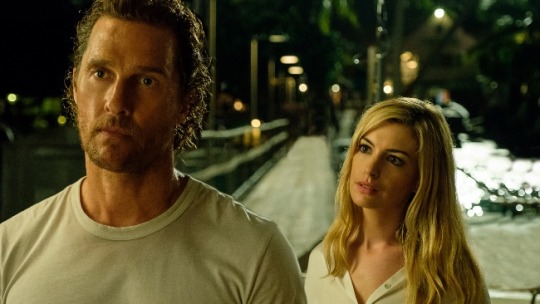
SERENITY (Aviron)
Written and directed by Steven Knight (Locke, Redemption, “Peaky Blinders,” “Taboo”) Cast: Matthew McConaughey, Anne Hathaway, Diane Lane, Jason Clarke, Djimon Hounsou MPAA Rating: R
The other new release of the weekend is something that possibly could have done very well in the ‘90s or early ‘00s as an erotic thriller, a genre that has had its ups and downs but has mostly done decently at the box office. This is the third movie from Steven Knight, the director of Lockeand writer of Eastern Promises, “Peaky Blinders” and “Taboo,” though I’m not sure his previous hits will convince many to see this in theaters.
Matthew McConaughey plays fishing boat captain Baker Dill, who has been living in hiding on Plymouth Island after his divorce. His ex-wife Karen, played by Anne Hathaway, shows wanting her to kill her violent and abusive husband (Jason Clarke) in order to save her and Baker’s teen son.
McConaughey’s career has been all over the place in recent years, but his recent crime-thriller White Boy Rick didn’t do very well, and it feels like Serenity is heading towards a similar fate. In fact, McConaughey has been in quite a string of bombs since winning an Oscar for 2013’s Dallas Buyers Club with his biggest hit being the animated Sing. His most high-profile movie The Dark Tower made $120 million worldwide based on $60 million budget which made it barely profitable but especially disappointing due to its studio’s franchise plans.
Having Anne Hathaway could help as she’s been a lot more careful about her choices since winning her own Oscar a year earlier with last year’s Ocean’s 8, in which she played herself,being a relative hit with almost $300 million worldwide. Her last movie with McConaughey was Christopher Nolan’s Interstellar in 2014, which grossed $188 million domestically, so that’s somewhat of a bonus. The cast is rounded out by the ever-present Jason Clarke, who has yet to really break-out despite being involved in many Oscar-caliber films, as well as Djimon Hounsou, who is becoming a superhero film regular, having just appeared in Aquaman and having roles in Captain Marveland Shazam. (Some might remember that he also had a great scene with Chris Pratt early in the first Guardians of the Galaxy movie.)
While erotic thrillers have done well in the past, this movie was originally supposed to come out last September, and there was advertising trailers all summer – I know that because I saw the trailer for this in front of a ton of movies – but then it was moved to January, which is never a good sign of faith. This is a rare release from fledgling distributor Aviron Pictures, who released just two movies in 2018. Aviron is releasing this one into just 2,500 theaters, which might already be too many screens considering how little marketing the film has
Reviews are still embargoed until Thursday (never a good sign), but I’m probably not going to review the movie, since I saw it quite some time ago, though I do have to say that that the big twist in this movie angered me more than anything in M. Night Shyamalan’s Glass.
This movie looks like the epitome of a late January bomb, one that probably won’t come close to $10 million for the weekend and might even end up closer to $5 million or a little more. Either way, it won’t have to make that much to end up in the top 5 this weekend since it’s going up against many movies that have been playing since before Christmas.
This week’s Top 10 should look something like this…
1. Glass (Universal) - $19 million -53%
2. The Kid Who Would Be King (20thCentury Fox) - $11.6 million N/A
3. The Upside (STX) – $10 million -33%
4. Serenity (Aviron) - $6.5 million N/A
5. Aquaman (Warner Bros.) - $5.5 million -47%
6. Dragon Ball Super: Brolly (Funimation) – $5 million -49%
7. Spider-Man: Into the Spider-verse (Sony) - $4.8 million -37%
8. A Dog’s Way Home (Sony) – $4.2 million -42%
9. Mary Poppins Returns (Disney) - $3.1 million -45%
10. Escape Room (Sony) - $2.8 million -46%
LIMITED RELEASES
Many of my colleagues will be heading to the Sundance Film Festival this week, but I’m not going, so I don’t have much to say about it. Sorry!
On a more local level , we get FIAF ANIMATION FIRST FEST over the weekend, focused on the booming French animation film industry with a 20thanniversary screening of Michel Ocelot’s Kirikou and the Sorceress and 17 US and New York premieres, including the New York premiere of Funanand a number of shorts programs. Studio Ghibli’s Isao Takahata, who died last year, will be honored. You can read the full program and schedule of events Here. I personally have never attended, but if I wasn’t busy I might check out some of the programs.
As far as the limited releases…
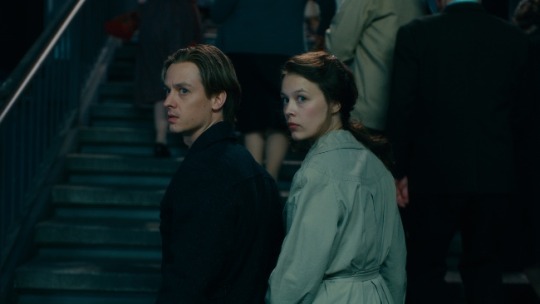
Following its November qualifying run as Germany’s Oscar entry and with two Oscar nominations under its belt, Oscar-winning filmmaker Florian Henckel von Donnersmarck’s (The Lives of Others) new movie NEVER LOOK AWAY (Sony Pictures Classics). The historic drama is loosely based on the life of visual artist Gerhard Richter with Tom Schilling (Woman in Gold) playing a young artist who has watched East Berlin go from Nazi occupation, watching his older sister be sentenced to death due to her mental illness by a ruthless Nazi doctor (Sebastian Koch), to falling in love with a young woman (Paula Beer) who happens to be that doctor’s daughter and escaping to West Berlin during the country’s contemporary art movement. I found the movie to be overly long and a little confusing, because I wasn’t sure what the movie was supposed to be about until about 30 minutes into it.
Just a few months after his last film The Mercy barely got a glance, The Theory of Everything director James Marsh’s new heist film KING OF THIEVES (Saban Films) will open in theaters (including New York’s Cinema Village) and on VOD and Digital HD on Friday. The true crime tale about a group of retired crooks trying to stage an elaborate jewelry heist stars an ensemble of legendary British actors in Michael Caine, Jim Broadbent, Michael Gambon, Ray Winstone, Tom Courtenay along with Charlie Cox aka Daredevil. I had high hopes for this movie being better than the likes of Zach Braff’s Going in Style, something classier like last year’s The Old Man and the Gun, but sadly, it’s an obvious money grab for older British men and women reminiscing about all the better crime movies made by the cast.
Claus Räfle’s docudrama THE INVISIBLES (Greenwich) follows four German-Jewish youth who decide to stay behind in Berlin as World War II is beginning, living vicariously while dodging Nazi officials before eventually joining the resistance. This story of survival opens at New York’s Quad Cinema and Landmark 57, as well as in L.A. at the Laemmle Royal on Friday.
The Brazilian animated film TITO AND THE BIRDS (Shout! Studios) from filmmakers Gustavo Steinberg, Gabriel Bitar and André Catoto tells the story of a boy and his father who are looking for the cure for an illness inflicted on someone after being scared. After playing a number of film festivals, it also opens at the Quad Cinema in New York
It’s hard to believe that 88-year-old French New Wave filmmaker Jean Luc Goddard is still with us and making movies, but all the recent repertory series in New York and L.A. have been leading up to his latest film THE IMAGE BOOK (Kino Lorber). Don’t know much about this film which received a special Palme d’or at Cannes last year, but apparently it’s a “collage film essay,” which means that it probably doesn’t have a plot or narrative that’s easy to explain. It opens at the IFC Center and Lincoln Center in New York.
Tom Arnold and Sean Astin star in Ron Carlson’s Dead Ant (Cinedigm) as the members of an ‘80s hair metal band called Sonic Grave who had a power ballad hit 30 years earlier, and while they’re on a road trip to Coachella, they find themselves trying to be relevant again…. Until they’re attacked by giant killer ants. Okay, I think I need to see this movie, as it seems like my kind of movie.
Playing for one night only nationwide on Thursday as a Fathom Event is Timothy Woodward Jr.’s horror film The Final Wish (Cinedigm), starring the wonderful Lin Shaye (Insidious), Michael Welsh, Melissa Bolona and Tony Todd, and produced by Jeffrey Reddic (writer/producer of Final Destination). Welsh plays Aaron Hammond who returns to his hometown after the death of his father to help his bereaved mother (Shaye) and deal with the demons from his past, finding a mysterious item while going through his father’s belongings.
Opening at New York’s Cinema Village on Friday and at L.A.’s Laemmle Music Hall on Feb. 1 is Francois Margolin’s controversial French drama Jihadists (Cinema Libre), co-directed by by Lemine Ould Salem, which was banned in France. It follows two filmmakers who were given access to fundamentalist clerics of Sunni Islam to show what it’s like to live your life under jihadi rule.
From Bollywood comes Vikas Bahl ‘s drama Super 30 (Reliance Entertainment), starring Hrithik Roshan as Patna-based mathematician Anand Kumar, who runs the famed and prestigious Super 30 program in Patna. Not sure of the theater count but it’s probably opening in a dozen or so theaters.
Opening on Wednesday following its premiere at Doc-NYC is Robert Townsend’s doc The 5 Browns: Digging through the Darkness, which looks at the 5 Browns, a group of Julliard-trained sibling pianists who rose to stardom only to be devastated when it’s revealed that the three sisters were sexually abused by their manager father Keith Brown. It opens at the IFC Center for a single-week run.
Also opening at the Cinema Village and in select cities is John Kauffman’s Heartlock (Dark Star Pictures), a love story about a female prison guard, played by Lesley-Ann Brandt, who becomes the subject of affection from a charming male convict (Alexander Dreymo) who wants to use their relationship to help him escape.
STREAMING

The main film streaming on Netflix on Friday is Jonas Akerlund’s POLAR, his follow-up to Lords of Chaos, which premiered at Sundance last year and comes out a few weeks later. Based on the Dark Horse graphic novel, it stars Mads Mikkelson as assassin Duncan Vizla, known as the Black Kaiser, who is getting ready for retirement in a suburban town when he’s dragged back into one last job, but when it goes wrong, Duncan’s new love interest (Vanessa Hudgens) is dragged into it. I’ve never read the graphic novel, and I’ve generally been mixed on Akerlund’s films, but this one is definitely in the same absolute insanity realm of his earlier film Spun with a lot of crazy over-the-top performance from the likes of Matt Lucas (Little Britain) and Johnny Knoxville (Jackass), but in this case, it’s not a good thing. Mikkelson gives another stellar performance, and Hudgens is also quite good (didn’t even recognize her) but the craziness surrounding them from Lucas and the other assassins sent after Duncan made it hard to enjoy the film, especially compared to Mikkelson’s other upcoming film Arctic, but hey, it’s on Netflix so I’m sure people will watch it anyway.
Speaking of which, I also want to note that last week, I didn’t notice that a science fiction film called IO: Last on Earth, starring Margaret Qualley (Novitiate),was also streaming on Netflix. I haven’t watched it yet, but one of the writers also co-wrote Claire Carée’s Embers, which is one of my favorite festival discoveries from the past few years.
REPERTORY
METROGRAPH (NYC):
The Metrograph has a couple new series starting Friday, including Hou Hsiao-Hsien in the 21st Century, featuring 35mm prints of four of the Chinese filmmaker’s recent films: Millenium Mambo, Three Times, Flight of the Red Balloon and Café Lumieré. Then on Saturday, the Metrograph will show the classic Gone with the Windto kick off its Produced by David O. Selznick series, and there’s some great stuff to come, including Alfred Hitchcock’s Spellboundand Rebecca. The theater will also be screening a 35mm of Ken Loach’s 1991 film Riff Raff, starring Robert Carlyle, who would breakout in Danny Boyle’s Trainspotting. On top of that, Kay Francis: Queen of Pleasure continues with William Dieterle’s Jewel Robbery (1932) and 1929’s The Cocoanuts this weekend, while this weekend’s Late Nites at Metrograph option is Chantal Akerman’s News from Home (1977) and Playtime: Family Matinees shows the 2015 animated film Shaun the Sheep.
THE NEW BEVERLY (L.A.):
Weds. and Thurs. see double features of the 1977 film The Late Show and ‘78’s The Big Fix, starring Richard Dreyfuss. Friday sees a double feature of American Graffiti (1973) and The Lords of Flatbush (1974) with More American Graffiti (1979) added on Saturday… for just 10 bucks!The weekend family matinee is 1947’s The Secret Life of Walter Mitty, starring Danny Kaye. The Sunday/Monday Franco Zeffirelli double feature is Romeo & Juliet (1968) with Brother Sun, Sister Moon (1972). Tarantion’s Jackie Brownonce again plays at midnight Friday and the Tuesday Grindhouse triple feature is Katt Shea’s Poison Ivy (1992), Streets (1990) and Stripped to Kill (1987), which is already sold out online but may have more tickets at the door.
FILM FORUM (NYC):
Far Out in the 70s: A New Wave of Comedy, 1969 - 1979 continues with La Cage Aux Folles and The Seduction of Mimi on Wednesday, double features of Who is Killing the Great Chefs of Europe? and Theater of Blood on Thursday, Woody Allen’s Sleeper and Bananas on Friday, then Blazing Saddles, Young Frankenstein, Rock ‘n’ Roll High School, Monty Python and the Holy Grail on Saturday, and Papermoon, What’s Up, Doc? starring Barbara Streisand and Woody Allen’s Play It Again Sam on Sunday. As part of the series focusing on the great filmmaker and actor Elaine May, Film Forum will show A New Leaf (1971) and Mickey and Nicky (1976) next Tuesday. The weekend’s Film Forum Jr. is Gordon Parks’ 1969 film The Learning Tree.
EGYPTIAN THEATRE (LA):
Beginning another fun series of double features this weekend with Argento/De Palma with a double feature of Suspiria and Carrie on Thursday, Blow Out and Inferno on Friday, and Dressed to Kill and Tenebrae on Saturday. Saturday sees a special presentation of Craig Owen’s The Silent Film Era at the Alexandria Hotel, while the 1916 Douglas Fairbanks film His Picture in the Papers will also screen on Saturday with live music accompaniment.
AERO (LA):
The AERO is offering an eclectic mixed bag of films this weekend including the 4k restoration of Wim Wenders’ Wings of Desire (1987; Janus Films) on Friday night, David Fincher’s Fight Club on Saturday, and the WC Fields comedy My Little Chickadee (1940) on Sunday night.
QUAD CINEMA (NYC):
Continuing the theater’s attempt to keep up with ‘90s Cinemax with its X-rated fare, Just Jaekin’s erotic drama Emmanuelle (Kino Lorber; 1974) will screen in a special engagement, leading up to next week’s Beyond Emmanuelle Just Jaeckin retrospective and Erotic Journeys: The Many Faces of Em(m)anuelle.
IFC CENTER (NYC):
On Friday and Saturday at midnight, the IFC Center will show the 4k restoration of Dario Argento’s Suspiria as part of its Late Night Favorites series. While The Image Book opens here on Friday, Weekend Classics: Early Godard continues with a 35mm print of A Woman is a Woman (1961) and Waverly Midnights: The Feds screens Michael Mann’s Manhunter(with Silence of the Lambs and Hannibal coming in the next two weekends!)
LANDMARK THEATRES NUART (LA):
Friday night’s midnight screening is the Rocky Horror Picture Show follow-up Shock Treatment (1981).
MOMA (NYC):
This week’s Modern Matinees: Sir Sidney Poitier offerings are A Patch of Blue (1965) on Weds, They Call Me Mr. Tibbs! (1970) Thurs, and No Way Out (1950) on Friday. MOMA is also screening Ida Lupino’s Never Fear (The Young Lovers) (1950) to end its 16th annual To Save and Project series, although there’s a couple second screenings for those (like me) who only just found out about it now.
That’s it for this week… next week, it’s February! Already?? While many movie writers are still at Sundance and others are preparing for Super Bowl Sunday, Sony releases the crime-thriller remake Miss Bala.
0 notes